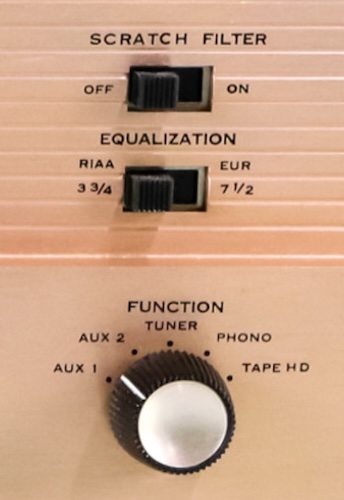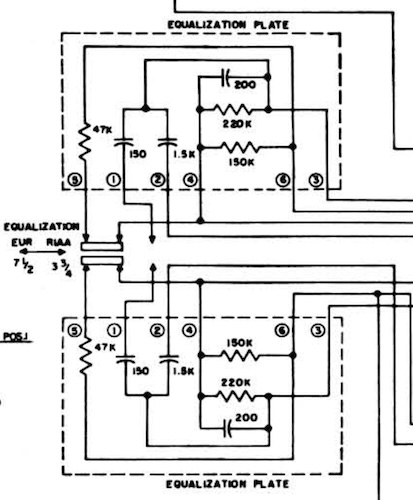EQカーブの歴史、ディスク録音の歴史を(私が独りで勝手に)学ぶ本シリーズ。前回 Pt.21 では、マイクログルーヴLP登場前から存在している周波数テストレコードの歴史を、録音カーブの視点から学びました。
On the previous Part 21, I learned the history and diversity of “Frequency Test Records”, which had been available since 1930s — i.e. before the microgroove record era.
今回の Pt.22 では、1950年代以降の 民生用アンプに内蔵されたフォノイコの変遷 について学んでいきます。
This time on Pt.22, I am going to learn and study the history of consumer amplifiers — especially the transition of the built-in phono equalizers — in the late-1950s to mid-1960s.
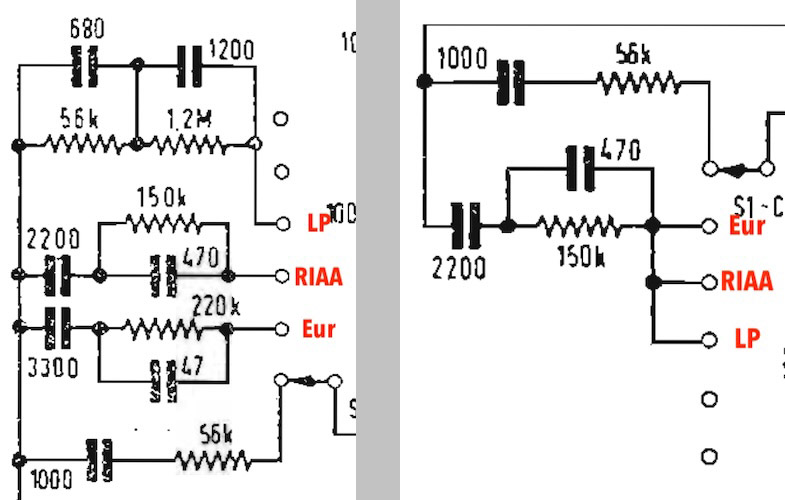
source: Scribd.
Bell 3030 アンプの PHONO プリアンプ部回路図抜粋
左チャンネルは Eur / RIAA / LP それぞれに専用フォノEQ回路があるのに、右チャンネルは3ポジションともに同一 (RIAA) 回路となっている
From Bell 3030 Amplifier’s schematic: right channel shares the RIAA de-emphasis circuit among the Eur / RIAA / LP position.
毎回書いている通り、筆者自身の学習過程を記したものですので、間違いの指摘や異論は遠慮なくお寄せください。
As I noted in every part of my article, this is a series of the footsteps of my own learning process, so please let me know if you find any mistakes on my article(s) / if you have different opinions.
いつものように長くなってしまいましたので、さきに要約を掲載します。同じ内容は最後の まとめ にも掲載しています。
Again, this article become very lengthy — so here is the summary of this article beforehand (the same summary are avilable also in the the summary subsection).
1958年春のステレオLP登場より以前は、民生用アンプのほとんどがモノーラルで、78回転盤やRIAA規格策定前の古いレコードへの対応のために複数フォノEQポジションを備えていた。
Prior to the introduction of stereo records in the spring of 1958, most consumer amplifiers were monaural, with multiple phono EQ positions to accomodate 78 rpm records as well as old LP records before the RIAA Standards was established.
その実装方法も、トーンコントロールで簡易的に代用するもの、ターンオーバー/ロールオフの独立設定式のもの、入力セレクタに複数カーブのポジションが配置されているもの、など、各社さまざまだった。また、同一名のEQポジションであっても、機種ごとにその特性が同一である保証は全くなかったことが、回路図の比較により確認された。
The implementation methods varied from company to company, with some using tone controls as a simple substitute, others using independent turnover/rolloff settings, and others placing multiple curve positions on the input selector knob. Also, there was no guarantee that the characteristics of the EQ positions would be identical from model to model, even if they had the same EQ position name — this can be easily confirmed by inspecting the schematics of the amplifiers.
モノーラル時代には、Marantz Audio Consolette (1951)、McIntosh C-108 (1954) / C-8 (1955)、Bogen PR100A (1955)、Fisher 80-C (1956)、H.H. Scott 121-C (1956) など、ターンオーバー/ロールオフを細かく設定可能な、現代の可変カーブ対応フォノイコの源流である実装が少なくなかった。
In the monaural era, there were a number of turnover/rolloff implementations that were the source of modern variable-curve-enabled phono preamps, including Marantz Audio Consolette (1954), McIntosh C-108 (1954) / C-8 (1955), Bogen PR100A (1955), Fisher 80-C (1956), H.H. Scott 121-C (1956).
しかしステレオ時代に入ると、McIntosh C-20 (1959)、Harman-Kardon Citation I (1960) / Citation “A” (1962) という貴重な例外を除き、非RIAAカーブ対応であってもせいぜい RIAA / Columbia LP / 78 の切替スイッチを備える程度へと収斂していった。また、1960年代中頃には RIAA ポジションオンリーのアンプの比率が8〜9割程度になっていた。
However in the stereo era, with the very rare exception of the McIntosh C-20 (1959), Harman-Kardon Citation I (1960) and Citation “A” (1962) preamps, most non-RIAA-compatible amplifiers converged on the RIAA / Columbia LP / 78 rpm switch. Also, by the mid-1960s, the percentage of RIAA-only amplifiers was about 80% to 90%.
1958年〜1960年頃、すなわちステレオレコード登場直後においては、複数のフォノEQポジションに対応しているステレオアンプであっても、非RIAAカーブの場合は左チャンネルのみに作用するよう実装されていたアンプが複数メーカで確認された。また、当時の取説を読むと、どのメーカ、どの製品でも「現代のLPおよびステレオ盤はRIAAポジションで聴くこと」と書かれていた。
Around 1958 to 1960 (just after the introduction of stereophonic records), several manufacturers were found to have stereo amplifiers that supported multiple phono EQ positions but were implemented so that non-RIAA curves would act only on the left channel. In addition, the instruction manuals of the time always stated that “modern LPs and stereo recordings should be listened to in the RIAA position” for all manufacturers and products.
唯一の例外が McIntosh C-22 (1963) / C-24 (1964) / MA230 (1964) で、これらに装備された RIAA / COL 切替スイッチについて、取説では「一部のステレオ盤および古いモノーラル盤では LP(COL) カーブが使用されている」と書かれていた。これについて McIntosh に問い合わせをしたが、当時の設計・開発者が全員他界しており、文面の意図を確認することができなかった。
The only exception for this was the McIntosh C-22 (1963) / C-24 (1964) / MA230 (1964), which were equipped with a RIAA/COL switch that stated in the owner’s manual that “Some stereo and early mono recordings use LP equalization”. I contacted McIntosh about this, but all the designers/developers at that time have passed away, so I could not confirm their intent of the statement.
Contents / 目次
- 22.1 Allied Radio Catalogs in late 1950s to early 1960s
- 22.1.1 1958 Allied Radio Catalog No. 170 (Sep. 1957)
- 22.1.2 1959 Allied Radio Catalog No. 180 (Sep. 1958)
- 22.1.3 1960 Allied Radio Catalog No. 190 (Sep. 1959)
- 22.1.4 1961 Allied Radio Catalog No. 200 (Sep. 1960)
- 22.1.5 1962 Allied Radio Catalog No. 210 (Sep. 1961)
- 22.1.6 1963 Allied Radio Catalog No. 220 (Sep. 1962)
- 22.1.7 1964 Allied Radio Catalog No. 230 (Sep. 1963)
- 22.2 “Audio” Magazine’s Annual Product Reviews
- 22.3 The summary of what I got this time / 自分なりのまとめ
22.1 Allied Radio Catalogs in late 1950s to early 1960s
実際にレコードをマスタリング(カッティング)する際のプロフェッショナル録音再生機材については、過去に多く学んできました。
So far I have learned a lot in the past articles about professional recording / reproducing equipment for the actual mastering (cutting) of records.
一方、1950〜1960年代当時、米国で販売されていた民生用アンプに内蔵されていたフォノイコライザには、どのようなものだったのでしょうか。イコライザ切替や微調整などの変遷は、時系列にみると、なんらかの特徴を見出すことはできるでしょうか。
On the other hand, what were the built-in phono equalizers in consumer amplifiers sold in the U.S. in the 1950s and 1960s? Can we find some characteristics of the changess in equalizer switching and fine-tuning when we look at the timeline?
そこで今回はまず、そのような素朴な疑問を出発点として、電子部品、ラジオキット、オーディオ製品などをカタログ販売していた老舗、Allied Radio の総合カタログに掲載された民生用アンプについて、その内蔵フォノイコポジションの変遷についてみていきましょう。
So, taking such a simple question as a starting point, let’s take a look at the evolution of the built-in phono equalizer positions of the consumer amplifiers listed in the general catalog of Allied Radio, a long-established catalog seller of electronic components and parts, radio kits, audio products and more.
Allied Radio 社は、ラジオやオーディオなど電子部品の製造・販売を行っていたほか、自社の民生用ブランド KNIGHT の完成品オーディオ機器やDIYキット販売を行っていました。
Allied Radio was a manufacturer and distributor of electronic components, including radio and audio, and also sold finished audio equipment and DIY kits under its own consumer brand KNIGHT.
同時に、他メーカのオーディオ機器やパーツ、DIYキットも扱っていたので、年次総合カタログを順に見ていくことで、当時米国で流通していた民生用オーディオ機器を時系列で把握できます。
At the same time, the company also handled audio equipment, parts and DIY kits from other manufacturers, so by going through the annual general catalogs in order, we can get a chronological overview of the consumer audio equipment distributed in the U.S. at the time.
Allied Radio 社は1928年に設立された、電子部品やキット、完成品をカタログ販売する老舗です。アマチュアラジオ製作ファン向けのパーツ販売、のちにオーディオマニア向けにオーディオパーツや完成品販売にも本腰を入れました。さらに1962年からはプロフェッショナル向けのカタログも追加されました。
Allied Radio, founded in 1928, is a long-established catalog seller of of electronic components, kits, and finished products. The company began selling parts to amateur radio enthusiasts, and later expanded into audio parts and finished products for audiophiles. In 1962, a catalog for professionals was added.
1967年に LTV Ling Altec, Inc. に買収され、さらに1970年に Radio Shack に売却されました。その後も引き続き、電子部品/オーディオ機器の総合カタログをほぼ毎年発行していたようです。Allied Radio の歴史については、以下のサイトにまとめられています。
Allied Radio was acquired by LTV Ling Altec, Inc. in 1967, and then sold to Radio Shack in 1970. The history of Allied Radio is summarized at the following websites:
また、Allied Radio カタログ(1929年度版〜)は以下のサイトにまとめられており、オンラインで閲覧可能です。
In addition, the Allied Radio catalog (from the 1929 edition) is compiled at the following website where we can read each edition online.
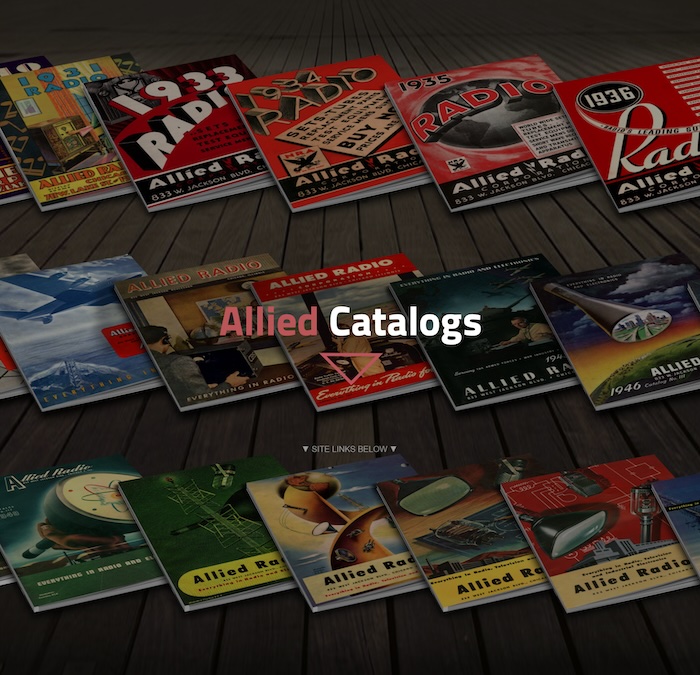
で、今回は、1950年代末〜1960年代中頃、Allied Radio カタログに掲載されたインテグレーテッドアンプ / プリアンプ / レシーバアンプなどをみていき、アンプに内蔵されたフォノEQポジションがどのように変化していったか、その傾向を探ってみたいと思います。
This time, we’re going to look at integrated amplifiers, pre-amplifiers, and receivers (tuner-amplifiers) which appeared in the Allied Radio catalog from the late 1950s to the middle 1960s, and explore how the phono EQ position in the amplifiers changed over time.
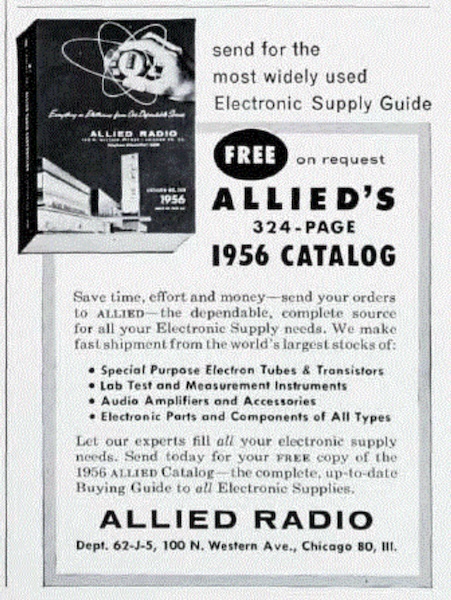
source: Physics Today, Vol. 8, No. 9, Sep. 1955, p.17
米国物理学会の機関誌「Physics Today」1955年9月号に掲載された、Allied Radio Catalog 1956年版の広告
年次カタログは前年の秋に刊行されていたことが分かる
Allied Radio Catalog Ad on Sep. 1955 issue of the Physics Today magazine (membership magazine of the American Institute of Physics), showing that Allied’s each annual catalog was published in the fall of the previous year.
45/45 ステレオ LP 登場直前の機器を捉えた 1958年号(1957年秋発行)から、1964年号(1963年秋発行)までに掲載されたアンプを追っていくことにします。ただし、今回はアンプ内蔵フォノイコをみていくため、パワーアンプ(フォノイコを備えていないアンプ)は除外します。
We will follow the amplifiers listed from the 1958 issue (published in the fall of 1957) which captured the equipment just before the 45/45 stereo LP was introduced, to the 1964 issue (published in the fall of 1963). However, as our interest is on built-in phono preamps, power amplifiers (i.e. amplifiers without phono preamps built-in) are excluded here.
同時に、各機種の取扱説明書および回路図・サービスマニュアルも、可能な限り探し出し読んでいくことにします。真空管時代のアンプについては、回路図・サービスマニュアルは比較的容易にアクセス可能なのですが、取扱説明書は、一部の機種ではどうしても見つかりませんでした(オンラインで有料販売されているものもあり)。
At the same time, I will try to locate and read as much as possible of the operating manuals, schematics and service manuals of each product. For amplifiers from the tube era, schematics and service manuals are relatively easy to access, but I could not find the operating manuals for some models by any means (some of them are sold online for a fee, though).
一方、Allied Radio カタログでは、当時の米国における主要メーカ・製品がほぼ網羅され掲載されているとはいえ、当時米国で売られていたすべての製品ではない点には注意が必要です。
It is important to note that, although the Allied Radio catalog includes almost all major manufacturers and products in the U.S. at that time, it does not include ALL products sold in the U.S. at the time.
Allied 社の自社ブランドである KNIGHT はさておき、他メーカの場合は、総合カタログに掲載してもらうために費用が必要だったでしょうし、掲載機種数を絞ったり、あるいは掲載を見合わせた年もあったでしょう。
Aside from KNIGHT (Allied’s own brand), other manufacturers would have had to pay to have their products listed in the catalog, and there would have been years when the number of models listed was limited or even suspended.
ですので、以下の本セクションの情報は、あくまで「当時の Allied Radio カタログに掲載された製品のみにおける傾向」であることに留意してください。
Therefore, please keep in mind that the information in this Section 22.1 is “trends only for products listed in the Allied Radio Catalog at that time”.
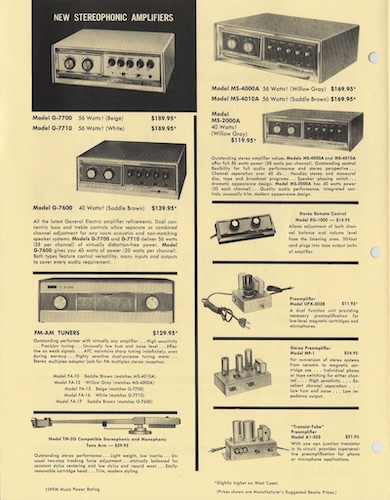
source: hifilit.com
1960〜61年頃のものと思われる GE (General Electric) パンフレットより
ここに掲載されたアンプは、いずれも Allied Radio Catalog には未掲載
GE brochure probably from 1960 or 61
none of these components appeared in the Allied Radio Caralog
22.1.1 1958 Allied Radio Catalog No. 170 (Sep. 1957)
まず、1958年カタログからみていきます。1957年秋発行と思われます。
First, let’s start with the 1958 catalog, which I believe was issued in the fall of 1957.
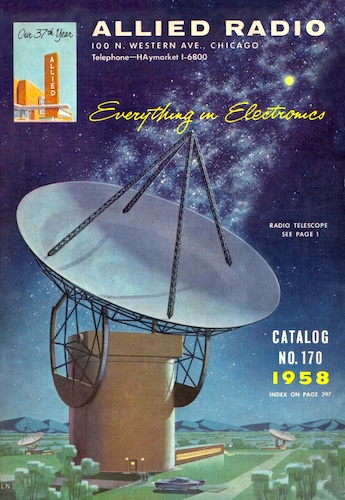
1957年秋発行ですので、45/45 方式ステレオレコードが正式採用となる前、すなわち、レコード目線ではモノーラルのみの最後の年となります。オープンリールテープの世界ではステレオ録音はすでに存在していました。
Since it was issued in the fall of 1957, this was the last year before the 45/45 stereophonic record was officially adopted, i.e. the last monaural-only year from the record’s perspective, although stereo recordings already existed in the world of reel-to-reel tapes.
オープンリールのステレオテープ向けとみられるステレオ対応アンプ(フォノはモノーラル入力のみ)も1機種のみ掲載されていますが、掲載されたほぼ全機種がモノーラルアンプです。
The vast majority of the amplifiers listed are monaural only, although one stereo-compatible amplifier (phono with monaural input only) that appear to be for reel-to-reel stereo tapes is listed.
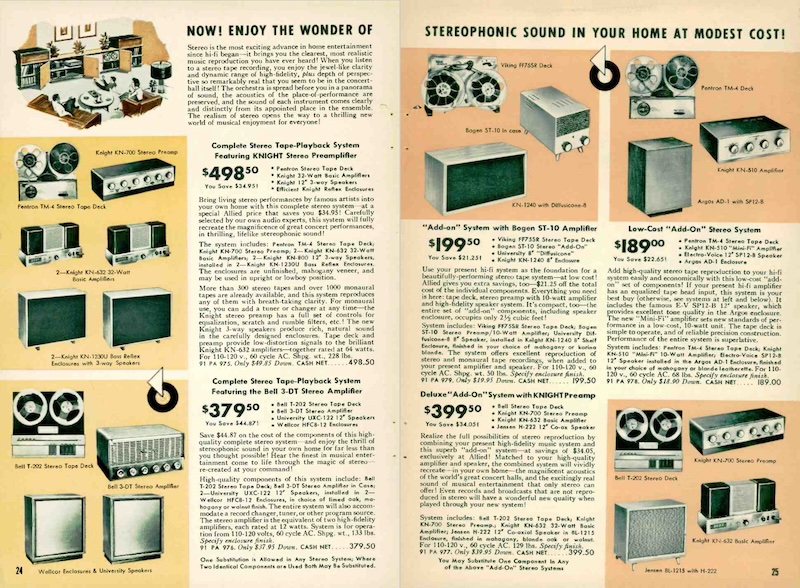
source: Allied Radio Catalog, No. 170, 1958, pp.24-25.
1958年版カタログの冒頭にあるおすすめコンポーネントセットのコーナーのうち、ステレオ用システムのページ
当時はまだステレオLP販売前なので、オープンリールデッキとセットとなっている
Allied’s recommended stereo component sets
stereo LPs were not debuted yet, so R2R decks here
6〜25ページは、Allied おすすめのコンポーネント組み合わせセットを紹介するページとなっています。
Pages 6 through 25 are devoted to Allied’s recommended component combination sets.
1958: KNIGHT (Allied Radio)
26ページから、Allied Radio 社が開発した KNIGHT ブランドのオーディオコンポーネントが順に紹介されています。インテグレーテッドアンプ、プリアンプ、レシーバアンプに絞ると、掲載されているのは KN-530 / KN-515 / KN-315 / KN-510 / KN-200 / KN-700 の6機種です。
Starting on page 26, the KNIGHT brand audio components developed by Allied Radio are listed in order. Narrowing down the list to integrated amplifiers, preamplifiers, and receivers, the six models listed are: KN-530 / KN-515 / KN-315 / KN-510 / KN-200 / KN-700.
| Model | Kind / Phono Pos. |
|---|---|
| KNIGHT KN-530 mono |
Integrated Amp, 30W |
| Turnover: Eur / ffrr / RIAA Rolloff: EUR / ffrr / RIAA |
|
| KNIGHT KN-515 “Bantam” mono |
Integrated Amp, 15W |
| Eur / ffrr / RIAA | |
| KNIGHT KN-315 “Uni-Fi” mono |
Tuner-Amp, 15W |
| Pop / 78 / LP | |
| KNIGHT KN-510 “Mini-Fi” mono |
Integrated Amp, 10W |
| RIAA / Eur | |
| KNIGHT KN-200 mono |
Tuner-Preamp |
| Eur / ffrr / RIAA / FLAT | |
| KNIGHT KN-700 STEREO (Tape, AUX) mono (Phono, Tuner, Mic) |
Preamp |
| Eur / ffrr / RIAA |
1957年秋の時点で、フォノイコのポジションは、最大で3種用意されていることになります(FLAT は除外)。
As of the fall of 1957, KNIGHT amplifiers had a maximum of three different phono positions available (excluding FLAT).
KN-315 の「Pop」「78」「LP」は、いかにも「正確なフォノイコ回路というよりは、イコライザとしてのスイッチぽい独自命名規則」ですね。そもそも民生用においては、カーブ名も、そのカーブの表す特性も、明確に規格化されていたわけではなかった、そんなRIAA以前の時代の名残なのですから、どんな名前にしようと自由、ということになるわけですが。
The KN-315‘s “Pop”, “78” and “LP” position names are a unique naming convention that makes it seem more like a switch for an equalizer than a precise phono compensation. In the first place, the names of curves and their characteristics were not clearly standardized for consumer use, and they are the vestiges of the pre-RIAA era — therefore, they were free to use any name(s) they liked.
また、本体裏の入力端子が「GE マグネットカートリッジ用」「Pickering マグネットカートリッジ用」「セラミック(圧電式)カートリッジ用」と3系統も用意されているのが、時代を表しています。
Also, the fact that there are three input terminals on the back of each unit, one for a GE magnetic cartridge, one for a Pickering magnetic cartridge, and one for a ceramic/crystal (piezo-electric) cartridge, is also indicative of the times.
当時の最上位機種の KN-530 の回路図 をみると、入力セレクタ部分でターンオーバーとベースシェルフの切り替えを行い、独立してロールオフセレクタがある、というのも興味深いです。
It is also interesting to note that the circuit diagram of KN-530 (KNIGHT’s top-of-the-line at the time) shows that the input selector switches between turnover and bass shelf, and has an independent roll-off selector.
つまり、RIAA カーブに準じるがロールオフだけ ffrr カーブと同等(50μs, 318μs, 3,180μs)といったセッティングも可能だったことになります。とはいえ、そういったマニアックな使い方は念頭におかれていなかっただろうと推測されますが。
In other words, it was possible to set up a phono compensation setting that conforms to the RIAA curve but has a roll-off equivalent to the ffrr curve (i.e. 50μs, 318μs, 3,180μs). However, it would be assumed that such a geeky usage was not intended.
また、1958年版カタログに掲載された全42アンプのうちで唯一ステレオである KN-700 プリアンプですが、ステレオなのは Tape / AUX 入力のみで、PHONO 入力などはモノーラルとなっています。
The KN-700 preamplifier, the only stereo among all the 42 amplifiers listed in the 1958 catalog, but only the Tape/AUX input is stereo, while the PHONO input and other inputs are monaural.
1958: Bogen
32〜33ページには、Bogen ブランドのオーディオコンポーネントが掲載されています。インテグレーテッドアンプ、プリアンプ、レシーバアンプに絞ると、掲載されているのは DB130 / HF10AG / D8100G / DB115 / RR550 / RR501C / PR100A の7機種です。
On pages 32-33, Bogen brand audio components are listed. Narrowing the list down to integrated amplifiers, preamplifiers, and recivers, the seven models listed are: DB130 / HF10AG / D8100G / DB115 / RR550 / RR501C / PR100A.
| BOGEN: Model | Kind / Phono Pos. |
|---|---|
| BOGEN DB130 mono |
Integrated Amp, 35W |
| Eur 78 / US 78 / AES / RIAA / COL-LP / NAB / POP | |
| BOGEN HF10AG “Challenger” mono |
Integrated Amp, 10W |
| 78 / 33・45 (RIAA) | |
| BOGEN DB110G mono |
Tuner-Amp, 12W |
| 78 / 33・45 (RIAA) | |
| BOGEN DB115 mono |
Integrated Amp, 15W |
| 78 / OLD / 33・45 (RIAA) | |
| BOGEN RR550 mono |
Tuner-Amp, 25W |
| RIAA / COL-LP / NAB / POP / EU-78 | |
| BOGEN RR501C mono |
Tuner-Amp, 10W |
| Pop / 78 / LP (RIAA) | |
| BOGEN PR100A mono |
Preamp |
| Turnover: 250 / 400 / 500LP / 500 / 629 / 800 Rolloff: 0 / -5 / -8 / -12 / -13.75 / -16 |
プリアンプの PR100A だけ、ターンオーバーとロールオフを詳細に設定できます。ターンオーバーの「500LP」と「500」の違いは、PR100A の回路図 をみる限り、ベースシェルフの有無(500LP がベースシェルフあり、500 はベースシェルフなし)のようです。
Only the PR100A preamplifier has detailed turnover / rolloff settings. The difference between “500LP” and “500” in turnover seems to be the presence or absence of the bass shelf (the former has the bass shelf 3,180μs, while the latter does not), according to the “>schematic of the PR100A.
1958: Pilot
続いて 34〜35ページは Pilot ブランドです。AA-920 / HF-42 / HF-30 / AA-903B / AA-900 がフォノイコを内蔵しています。
Next on pages 34-35 are the Pilot brand. Amplifiers with built-in phono EQs are: AA-920 / HF-42 / HF-30 / AA-903B / AA-900.
| Model | Kind / Phono Pos. |
|---|---|
| PILOT AA-920 mono |
Integrated Amp, 20W |
| LP / AES / RIAA / NARTB | |
| PILOT HF-42 mono |
Tuner-Amp, 20W |
| LP / NAB / RIAA / AES | |
| PILOT HF-30 mono |
Tuner-Amp, 12W |
| RIAA; variable Bass and Treble (marked LP / RIAA / AES) | |
| PILOT AA-903B mono |
Integrated Amp, 14W |
| LP / RIAA / AES / NARTB | |
| PILOT AA-900 mono |
Integrated Amp, 10W |
| LP / AES / RIAA / NARTB |
基本的には、フォノEQポジションごとに抵抗値を切り替えるRC回路ですが、HF-30 レシーバアンプのみ、回路図をみると可変抵抗のトーンコントロール(BASS / TREBLE)で代用するタイプで、おおよその近似値としてトーンコントロールノブ周辺にカーブ名が示されており、つまり正確なカーブではないことになります。
Basically, all models have phono EQ secion consisting of RC circuits that switch resistance values for each phono EQ position, but only the HF-30 receiver uses a variable risistance tone control (BASS/TREBLE) as a substitute for the phono EQ, and the curve name is shown around the tone control knobs as an approximate value — in other words, this particular model doesn’t provide precise phono EQ curves.
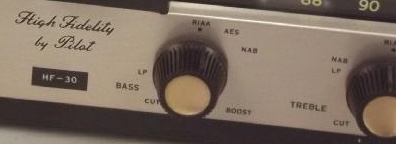
source: Radiomuseum: Pilot HF-30.
トーンコントロール (Bass / Treble)に、LP, RIAA, AES, NAB と書かれている。この NAB はレコードではなくテープ規格を表していると思われる(回路図ではなく取説が見つかれば。。。)
1958: Harman-Kardon
36〜37ページは Harman-Kardon ブランドです。A-120 / A-12 / A-1040 / TA-12 / TA-120 / TA-1040 がフォノイコを内蔵しています。
Next on pages 36-37 are the Harman-Kardon brand. Amplifiers with built-in phono EQs are: A-120 / A-12 / A-1040 / TA-12 / TA-120 / TA-1040.
| Model | Kind / Phono Pos. |
|---|---|
| Harman-Kardon A-120 “Melody II” mono |
Integrated Amp, 20W |
| LP / RIAA / Eur | |
| Harman-Kardon A-12 “Prelude II” mono |
Integrated Amp, 12W |
| LP / RIAA / RIAA with rumble filter / Eur | |
| Harman-Kardon A-1040 “Trend II” mono |
Integrated Amp, 40W |
| LP / RIAA / Eur | |
| Harman-Kardon TA-12 “SOLO II” mono |
Tuner-Amp, 12W |
| LP / RIAA / Eur | |
| Harman-Kardon TA-120 “Recital II” mono |
Tuner-Amp, 20W |
| LP / RIAA / Eur | |
| Harman-Kardon TA-1040 “Festival II” mono |
Tuner-Amp, 40W |
| LP / RIAA / Eur |
面白いのが A-1040 の取説に書かれた EQ カーブに関する説明で、LP ポジションが「1954年以前の大半の米国盤、一部の欧州盤」、RIAA が「1954年以降の大半の米国盤、および (1954 改訂) AES / (1953 NARTB を意味する) NAB / RCA Victor New Orthophonic / RIAA と書かれた盤」、そして EUR が「大半の欧州盤、一部の米国盤、多くの78回転盤」向け、とされています。
Interesting is the description of the EQ curve in the A-1040‘s operating manual. According to it, the LP position is for “Most American long-playing records made before 1954 and some European LP’s”; RIAA is for “Most American records made after 1954, all records cut to standards of Audio Engineering Society, NAB, new RCA Victor Ortho, and newly standardized RIAA”; and EUR for “Most European Long-playing, some American LP’s, and most 78 rpm discs”.
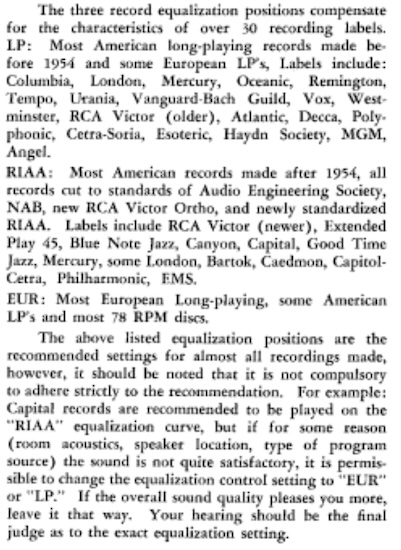
source: Harman-Kardon “Trend II” Model A-1040 Custom High FIdelity Amplifier Operation and Service Instructions.
当該機種のEQカーブポジションは LP / RIAA / EUR の3つだが、「だいたいこのカーブで」というざっくりした分類となっている
ターンオーバー / ロールオフ / ベースシェルフの厳密な定義が RIAA 以前には録音側にもなかったこと、そして再生機器メーカ側もおおよそで対応していたことが伺える
いかにも、な感じでレーベル名も書かれていますが、この辺りはあくまで「ざっくり」であり、あまり厳密にこだわっていなかったであろうことも伝わってきます。「まぁ、いい感じで聞こえるやつを選んでね」といった感じで。
The names of the label are also noted in a plausible manner. However, it may suggest that it was written in a “rough” matter rather than with strict attention to detail. It is rather like: “well, just pick the one that sounds good to you”.
1958: Fisher
38〜39ページは FISHER ブランドです。フォノイコ内蔵製品は 80-T / 500 / PR-6 / TR-1 / CA-40 / 80-C です。
On pages 38-39 are FISHER products. Amplifiers with built-in phono EQs are: 80-T / 500 / PR-6 / TR-1 / CA-40 / 80-C.
TR-1 は、1956年に販売開始された、米国民生用としておそらく最初のソリッドステート(トランジスタ)アンプ のようです。
The TR-1 probably was the first solid-state (transistor) amplifier for consumer use in the U.S., launched in 1956.
| Model | Kind / Phono Pos. |
|---|---|
| Fisher 80-T mono |
Tuner-Preamp |
| Eur / AES / RIAA / LP / NAB / 78 | |
| Fisher 500 mono |
Tuner-Amp, 30W |
| AES / RIAA / LP / NAB | |
| Fisher PR-6 mono |
Preamp |
| RIAA | |
| Fisher TR-1 mono transistor |
Preamp |
| RIAA | |
| Fisher CA-40 Master Control mono |
Integrated Amp, 25W |
| Eur / AES / RIAA / LP / NAB | |
| Fisher 80-C Master Audio Control mono |
Preamp |
| Turnover: AES / LP / RIAA-ORTHO / NAB Rolloff: FLAT / AES / RIAA-ORTHO / LP-NAB |
これらの中で最も本格的なモノーラルプリアンプ 80-C Master Audio Control は 1955年に登場した製品で、ターンオーバー(含ベースシェルフ)とロールオフを独立して設定可能です。また、マグネットカートリッジ用とセラミック(圧電式)カートリッジ用の2系統の入力を備えています。
Among these, the most authentic monaural pre-amplifier, 80-C Master Audio Control, was introduced in 1955, and offers independent turnover (incl. bass shelf) and rolloff settings. It also has two phono inputs — one for magnetic cartridges, and the other for ceramic (piezoelectric) cartridges.
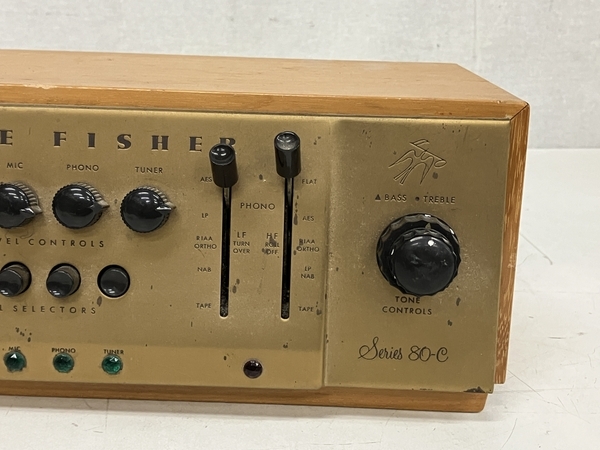
source: Yahoo! Auction Japan
Fisher 80-C Master Audio Control の LF (Turnover) / HF (Rolloff) 操作レバー

source: The Fisher Master Audio Console Series 80-C INstallation, Operating and Service Instructions.
Fisher 80-C 取説に掲載された低域x4 + 高域x4 のフォノEQポジションのグラフ
また、コンパクトサイズのプリアンプ、PR-6(真空管)と TR-1(ソリッドステート)では、フォノEQ は RIAA のみとなっているのにも注目です。
Also of note are the compact-sized preamplifiers, the PR-6 (tube) and TR-1 (solid-state), with RIAA-only phono EQ built-in.
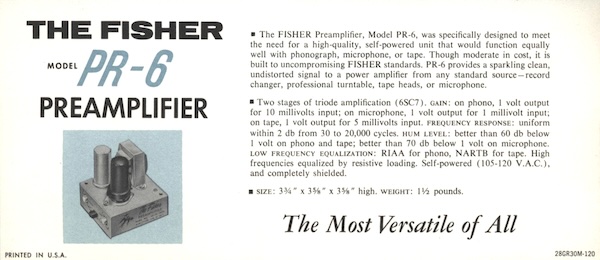
source: The Fisher K-10 / PR-6 brochure (Steam Powered Radio)
PR-6 パンフレットより。レコードは RIAA のみ、テープヘッドは NARTB のみ対応。
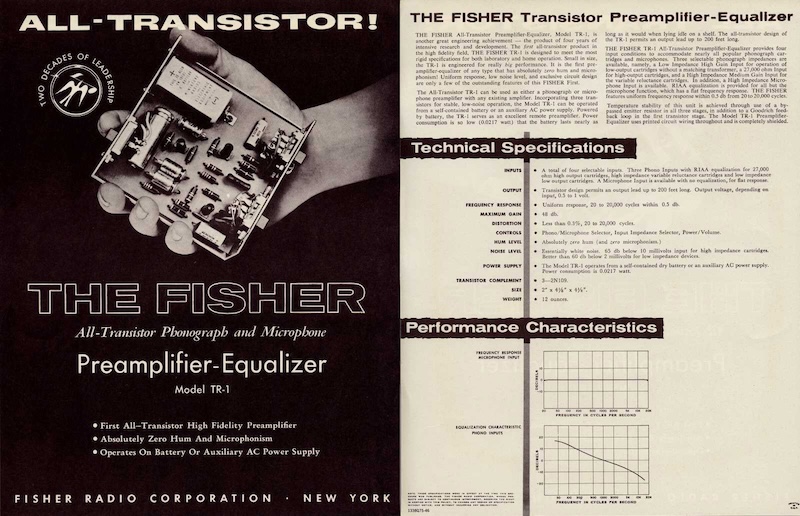
source: hifilit.com
おそらく世界初の市販ソリッドステート(トランジスタ)アンプと思われる Fisher TR-1 (1956) のパンフレット
RIAA 補正回路内蔵と書かれている
1958: H.H. Scott
40〜41ページは H.H. Scott ブランドです。99-D / 210-F / 121-C の3コンポーネントがフォノイコを内蔵しています。
On pages 40-41 are H.H. Scott products. Amplifiers with built-in phono EQs are: 99-D / 210-F / 121-C.
| Model | Kind / Phono Pos. |
|---|---|
| H.H. Scott 99-D mono |
Integrated Amp, 22W |
| Eur 78 / Orig. Lon. / Orig. AES / RIAA-NARTB-ORTHO / Orig. Col. | |
| H.H. Scott 210-F mono |
Integrated Amp, 36W |
| Eur 78 / Orig. Lon. / Orig. AES / RIAA-NARTB / Orig. Col. | |
| H.H. Scott 121-C mono |
Preamp |
| Turnover & Rolloff: continuously variable |
この中で 121-C Equalizer-Preamplifier が最も目をひきます。なんといっても、ターンオーバーとロールオフが可変抵抗により連続可変で、かつ、トーンコントロール(BASS / TREBLE)とは独立して与えられています。
Of these, the 121-C Equalizer-Preamplifier is the most eye-catching. THe turnover and rolloff are continuously variable with variable registers, and are independent of the tone controls (BASS/TREBLE).
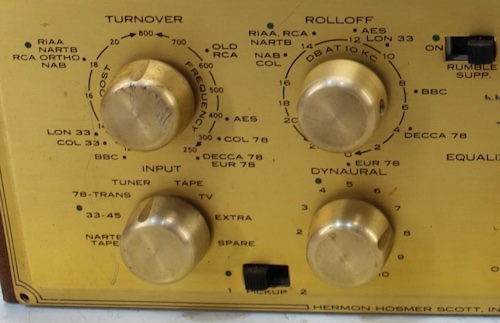
source: Invaluable, Lot 193.
H.H. Scott 121-C のフォノEQ設定ノブ
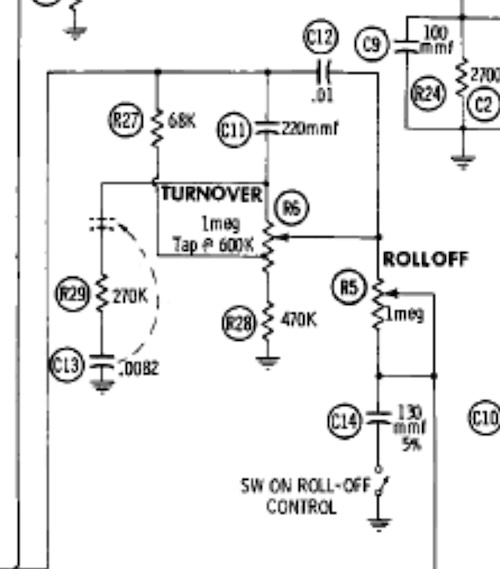
source: H.H. Scott 121-C Schematics.
121-C 回路図のうちターンオーバー / ロールオフ部分を拡大したもの
いずれも可変抵抗で値を変更するタイプ
1958: Marantz, McIntosh
そして、41ページ下部には、現在でもマニアの多い marantz Audio Consolette (1952) と McIntosh C-8 (1954) という代表作が並びます。
And at the bottom of page 41 are the marantz Audio Consolette (1952) as well as McIntosh C-8 (1954), two masterpieces that are still coveted by enthusiasts today.
| Model | Kind / Phono Pos. |
|---|---|
| marantz Audio Consolette mono |
Preamp |
| Turnover: FLAT / 300 / 400 / 500 ORTHO / 500 COL / 800 Rolloff: FLAT / 5000 -3dB / 2500 / 2000 / 1500 / 1000 -2.5dB |
|
| McIntosh C-8 Audio Compensator mono |
Preamp |
| Turnover: combination of 280 / 400 / 580 / 750 / 950 Rolloff: combination of 5 / 10 / 15 / 20 / 25 |
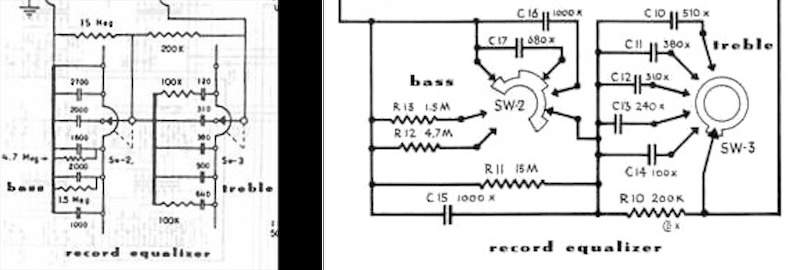
source: audioservicemanuals.com and rubli.net.
Marantz Audio Consolette 回路図のフォノEQ部分
左が前期型、右が後期型(シリアル番号3,000番以降)
McIntosh C-8 の EQ 設定表 および前身の McIntosh C-108 の EQ 設定表 は有名ですね。
The EQ setting table of the McIntosh C-8 and that of its predessor C-108 are well known.
1958: Bell, Grommes, Sherwood
42〜43ページには、Bell、Grommes、Sherwood というブランドが並びます。個人的は、Bell Sound 以外はあまり馴染みのないブランド名ですが、当時の米国ではポピュラーなメーカだったようです。
On pages 42-43, the brands Bell, Grommes, and Sherwood are listed. I personally am not familiar with any of these brands except Bell Sound, but it seems that they were popular manufacturers in the U.S. at that time.
| Model | Kind / Phono Pos. |
|---|---|
| Bell 2315 mono | Integrated Amp, 12W |
| RIAA / 78 / Eur | |
| Bell 2325 mono | Integrated Amp, 20W |
| 78 / RIAA / LP / Eur | |
| Bell 2360 mono | Integrated Amp, 50W |
| 78 / RIAA / LP / Eur | |
| Bell 2285 “Pacemaker” mono | Integrated Amp, 10W |
| RIAA | |
| Grommes 18PG8 mono | Integrated Amp, 15W |
| 500-FLAT / RIAA / Early LP | |
| Grommes LJ-6 mono | Integrated Amp, 10W |
| Phono FLAT / RIAA / Old LP | |
| Sherwood S-1000 II mono | Integrated Amp, 36W |
| LP / Lon. / RIAA-AES / Eur |
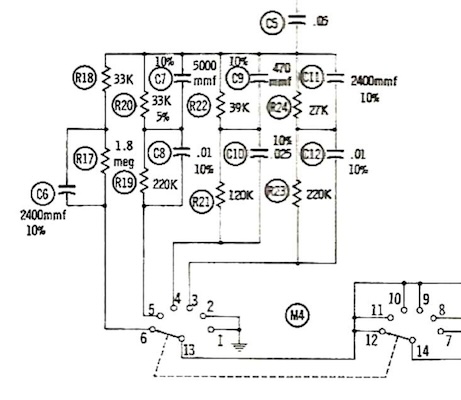
source: ElektroTanya.
Bell Sound 2315 回路図のフォノEQ 部分
左 (6) から右 (3) に、TAPE / 78 / EUR / RIAA / RADIO / AUX と、セレクタがフォノEQに直結している
フォノEQポジションの設定、そして各ポジションの設計思想が、メーカごとにバラバラであることが分かります。また、Bell 2285 では、RIAA オンリーとなっています。
It is clear that the phono EQ position names, and the design philosophy behind each position, varies from manufacturer to manufacturer. In addition, the Bell 2285’s built-in phono EQ is RIAA-only.
1958 Allied Catalog: Summary and My Impression
| Stereo | 1 (only for Tape/AUX: mono for Phono) |
|---|---|
| Mono | 41 |
| Tube | 41 |
|---|---|
| Transistor | 1 |
| RIAA only | 3 |
|---|---|
| RIAA w/ pseudo EQ (tone control) | 1 |
| Switchable EQ | 32 |
| Variable EQ (Turnover / Rolloff) | 5 |
この1958年版カタログ(1957年秋出版)では、11メーカ42製品がフォノEQ内蔵でした。その多くは、1950年代前半からの流れを引き継いでおり、RIAA 以外の再生カーブにも対応するものでした。
In this 1958 Allied Catalog (published in the fall of 1957), 42 products from 11 manufacturers had built-in phono EQs. Many of these products continued the trend from the early 1950s and were compatible with non-RIAA playback curves.
比較的新しい製品では、少ないながらも RIAA オンリーと割り切った製品も目につきました。
On the other hand, we also saw a small number of relatively new products that were RIAA-only.
また、ほとんどのアンプが、マグネットカートリッジ用入力端子と、クリスタル/セラミック(圧電式)カートリッジ用入力端子の両方を備えています。後者は、専用の入力端子を備える機種も一部にありますが、多くは AUX(外部入力)端子との兼用であり、専用のフォノEQは装備していません。
Most amplifiers also have both input jacks for magnetic cartridges and crystal/ceramic (piezo-electric) cartridges. SOme models have dedicated input terminals for the latter, but most use them in combination with auxilary inputs and do not have dedicated phono EQs.
それぞれの製品の取説マニュアルを探し回路図を眺めてみましたが、フォノEQ回路の実装方法やパラメータがもののみごとに多種多様で、同じ「RIAA」「LP」「AES」などのポジション名であっても、その再生カーブが一緒とは限らないことも確認できました。
I searched through the instruction manuals of each product and looked at the circuit diagrams, which showed a great variety of implementation methods and parameters for the phono EQ circuitry. I also found that even if the position names were the same, such as “RIAA”, “LP”, and “AES”, the implemented playback curves were not always the same.
特に、ステレオLP登場前夜の1957年秋の時点で、トーンコントロールでフォノEQカーブ変更の代用としている、Pilot HF-30 のような製品が存在していたことは、自分には新しい発見でした。
In particular, it was a new discovery for me that in the fall of 1957, on the eve of the advent of stereo records, products like the Pilot HF-30 existed that used tone controls as a substitute for changing the phono EQ curve.
22.1.2 1959 Allied Radio Catalog No. 180 (Sep. 1958)
続いて、1959年カタログをみていきます。1958年秋頃の発行と思われます。
Let’s move on to the 1959 Allied Catalog, which I believe was issued in the fall of 1958.

1958年春頃に 45/45 方式ステレオLPの流通が始まり、それにあわせて各オーディオ機器メーカが一斉にステレオアンプ、ステレオカートリッジなどをリリースします。
Around the spring of 1958, 45/45 stereo records began to be distributed, and audio equipment manufacturers simultaneously released stereophonic amplifiers, stereo cartridges, etc.
それを反映して、カタログ冒頭のおすすめコンポーネントセットのコーナーも前年カタログよりページ数が大幅に増え、ステレオLP対応のおすすめ組み合わせ例が次から次へと紹介されています。
Reflecting this, recommended component set section at the opening pages of the Allied Catalog has significantly more pages than the previous year’s catalog, with one example after another of recommenended component combinations for stereo records.
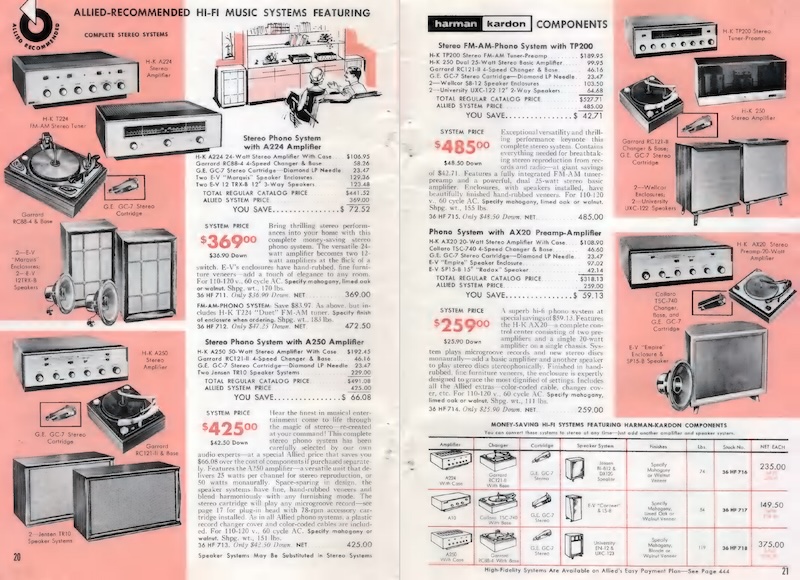
source: Allied Radio Catalog, No. 180, 1959, pp.20-21.
1959年版カタログの冒頭にあるおすすめコンポーネントセットのコーナーのうち、Harman-Kardonのコンポを含んだステレオ用おすすめシステム構築例
Allied’s recommended stereo component sets featuring harman-kardon components
また、従来のモノーラルシステムを所有するユーザ向けに、もう1チャンネル分アンプとスピーカを買い足し、ステレオ対応フォノカートリッジもセットにした「アドオンシステム」の紹介にもページが割かれています。
Pages are also devoted to “add-on system” for users who already own a conventional monaural system, which includes the purchase of another amplifier and another loudspeaker for additional channel, plus a stereo-compatible phono cartridge.
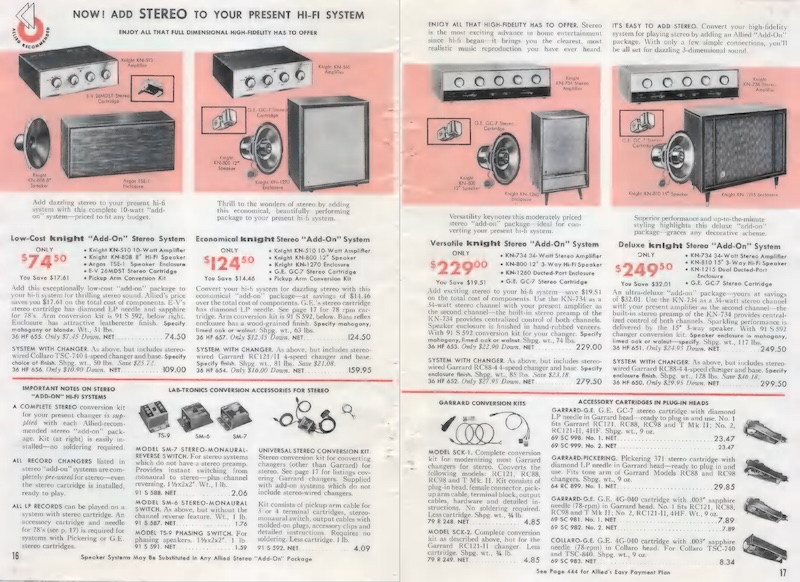
source: Allied Radio Catalog, No. 180, 1959, pp.16-17.
1959年版カタログの冒頭にあるおすすめコンポーネントセットのコーナーのうち、既存のモノーラルシステムへのアドオン用コンポ例の紹介
Allied’s recommended ADD-ON components to get the monaural system to stereo.
各メーカごとのコンポーネント紹介ページのうち、アンプ系は32〜55ページで、扱われているメーカは前年度版とほぼ同一です。
Among the audio component pages for each manufacturer, the amplifier system is on pages 32 to 55, and the manufacturers covered are almost the same as in the previous year’s edition.
しかし、ステレオ対応元年ということもあり、新製品が大量に登場しています。
However, as it was the first year of stereo compatibility, a large number of new products were being introduced.
1959: KNIGHT (Allied Radio)
Allied Radio の KNIGHT ブランドでは、1958年カタログの KN-700 がステレオ対応の改良版 KN-700A に進化しています。これに際し、EUR / ffrr / RIAA と3ポジションあったフォノEQのポジションが、「マグネットカートリッジ (RIAA)」「セラミックカートリッジ」、つまり実質RIAA一択になっています。
Among Allied Radio’s KNIGHT components, the KN-700 from the 1958 catalog evolved into the improved KN-700A with stereo compatibility. In this version, the phono EQ position, which had been EUR, ffrr, and RIAA, was changed to “magnetic cartridge (RIAA)” and “ceramic cartridge”, in other words, only RIAA is supported.
ステレオ対応新製品で唯一 RIAA 以外に対応しているのが KN-720 で、こちらは RIAA / EUR / LP となっています。
The only new stereo-compatible product that supports other than the RIAA curve is KN-720, which supports RIAA / EUR / LP.
ただし、回路図を見る限り、EUR / LP は左チャンネルのみにのみ実装されており、フロントの「STEREO PHONO / MONAURAL PHONO」スライダスイッチを MONO にした際に、左チャンネルの入力がフォノEQを通過する仕組みになっているようです。
However, as far as the circuit diagram shows, EUR and LP positions are implemented only on the left channel, and it seems that the left channel input passes through the phono EQ, when the front “STEREO PHONO / MONAURAL PHONO” slider switch is set to MONO.
つまり、KNIGHT 社の製品では、EUR や LP といったポジションは、ステレオ盤向けではない、という実装となっています。
In other words, KNIGHT’s implementation is such that the EUR and LP positions are not intended for stereo recordings.
| Model | Kind / Phono Pos. |
|---|---|
| KNIGHT KN-720 “Bantam” STEREO |
Integrated Amp, 20W or 10W×2 |
| RIAA / EUR / LP (left channel only except RIAA) | |
| KNIGHT KN-734 STEREO |
Integrated Amp, 34W or 17W×2 |
| Magnetic (RIAA) / Ceramic | |
| KNIGHT KN-700A STEREO |
Preamp |
| Magnetic (RIAA) / Ceramic | |
| KNIGHT KN-510 “Mini-Fi” mono |
Integrated Amp, 10W |
| RIAA / Eur |
1959: H.H. Scott
続く H.H. Scott 社も、最新式ステレオアンプをラインアップしています。モデル 299 は、RIAA / Eur 78 切替式で、他カーブには RIAA にした上でトーンコントロールで対応するパターンです。つまり、RIAA / Eur 78 以外は厳密な再生用フォノEQカーブにはなってなさそうです。
H.H. Scott also offers a latest stereo amplifier lineup. Model 299 is RIAA / Eur 78 switchable, with tone controls to accomodate other curves. In other words, it doesn’t seem to be a strictly playback phono EQ curve except for RIAA and Eur 78.
| Model | Kind / Phono Pos. |
|---|---|
| H.H. Scott 299 STEREO |
Integrated Amp, 20W×2 |
| Eur 78 / RIAA-NARTB-ORTHO (fine-tuning with bass/treble controls) | |
| H.H. Scott 130 STEREO |
Preamp |
| Eur 78 / Orig. Lon. / Orig. AES / RIAA / Orig. Col. | |
| H.H. Scott 210-F mono |
Integrated Amp, 36W |
| Orig. Lon. / RIAA-NARTB / Orig. Col. | |
| H.H. Scott 99-D mono |
Integrated Amp, 22W |
| Eur 78 / Orig. Lon. / Orig. AES / RIAA-NARTB-ORTHO / Orig. Col. | |
| H.H. Scott 209 mono |
Integrated Amp, 36W |
| Eur 78 / Orig. Lon. / Orig. AES / RIAA / Orig. Col. |
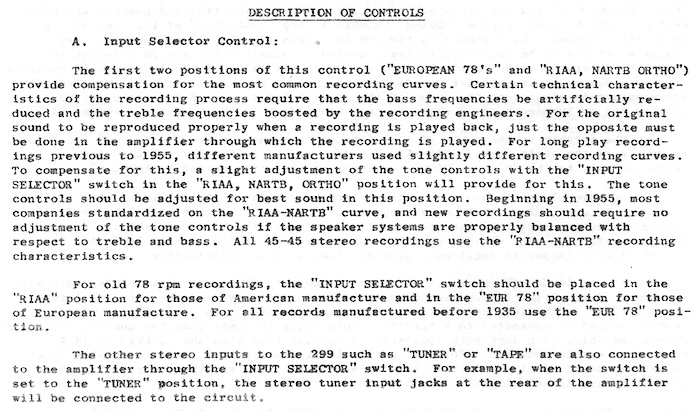
source: AudioKarma Database.
H.H. Scott 299 取説に書かれたEQカーブ設定に関する記述
「1955年以降はRIAAに設定」「米78回転盤はRIAAに設定後トーンコントロールを使う」「欧州78回転盤はEURに設定後トーンコントロールを使う」「45/45ステレオ盤は全てRIAA」と記載がある。
1959: Harman-Kardon
Harman-Kardon もステレオアンプを3種新登場させています。そのうち A-250 を除き RIAA オンリーになっています。
Harman-Kardon also introduces three new stereo amplifiers. All but the A-250 are RIAA-only.
唯一非RIAA対応の A-250 は RIAA / Eur 切替式で、左右チャンネルに同一のフォノEQ回路が実装されているのが確認できます。これはステレオオープンリールテープのEQスイッチも兼ねているためでしょう。
The A-250, the only non-RIAA model, is RIAA/Eur switchable, with identical phono EQ circuits on the left and right channels. This is probably because it also serves as an EQ switch for stereo reel-to-reel tapes.
フロントパネルのフォノEQ切替スイッチ
フォノの EUR / RIAA 切替と、テープの 7½ / 3¾ 切替を兼ねているスイッチ
また、AX-20 は過渡期の興味深い製品で、ステレオインテグレーテッドアンプですが、パワー段は片チャンネル分しか搭載されておらず、既存のモノーラルシステムのアンプを生かしてステレオ化するための製品のようです。
The AX-20 is also an interesting transitional product: it is a stereo integrated amplifier, but it has only one channel of power amplifier stage, and appears to be a product for making use of an existing monaural amplifier to convert it to stereo-compatible.
| Model | Kind / Phono Pos. |
|---|---|
| Harman-Kardon A-224 “Trio” STEREO |
Integrated Amp, 12W×2 |
| Phono Lo. (RIAA) / Phono Hi. (RIAA) | |
| Harman-Kardon A-250 “Epic” STEREO |
Integrated Amp, 25W×2 |
| RIAA / Eur | |
| Harman-Kardon FA-10 “Sonata” mono |
Tuner-Amp, 10W |
| RIAA | |
| Harman-Kardon A-10 “Allegro” mono |
Integrated Amp, 10W |
| RIAA | |
| Harman-Kardon AX-20 “Add-On” STEREO |
Integrated Amp, 20W×1 (another amp needed) |
| RIAA |
1959: Pilot
Pilot もステレオアンプを4種新登場させています。ステレオアンプではすべての機種で、フォノEQセレクタは Pilot HF-30 のときと同様、可変抵抗によるトーンコントロールで代用となっています(各機種の回路図で確認)。
Pilot also introduced four new stereo amplifiers. In all stereo amplifier models, the phono EQ selector is replaced by tone controls (variable resistors), as was the case with the Pilot HF-30. This can be confirmed by the circuit diagram of each model.
一方、モノーラルアンプは従来通り入力セレクタ内で4カーブ選択となっています。
On the other hand, the monaural amplifiers have the same four-curve selection in the input selector as before.

source: eBay listing by fox16fox.
Pilot SP-210 フロントパネルより
トーンコントロールとフォノEQ微調整が兼用となっている
| Model | Kind / Phono Pos. |
|---|---|
| Pilot SM-245 STEREO |
Integrated Amp, 32W or 16W×2 |
| RIAA; variable Bass and Treble (marked LP / RIAA / AES / NAB) | |
| Pilot FA-690 STEREO |
Tuner-Preamp |
| RIAA; variable Bass and Treble (marked LP / RIAA / AES / NAB) | |
| Pilot SP-210 STEREO |
Preamp |
| RIAA; variable Bass and Treble (marked LP / RIAA / AES / NAB) | |
| Pilot SP-216 STEREO |
Preamp, 10W |
| RIAA; variable Bass and Treble (marked LP / RIAA / AES / NAB) | |
| Pilot AA-920 mono |
Integrated Amp, 20W |
| LP / NAB / RIAA / AES | |
| PILOT AA-903B mono |
Integrated Amp, 16W |
| LP / NAB / RIAA / AES |
1959: Bell
Bell のアンプ(新登場のステレオアンプは1種類のみ)は、いずれもマグネットカートリッジ用とセラミックカートリッジ用と2系統の入力を備えています。
All of the Bell amplifiers listed (only one new stereo amplifier) have two phono inputs, one for magnetic, the other for ceramic.
Bell 3030 の回路図 を見てびっくりしたのですが、Eur / RIAA / LP 用に別々のRC回路が実装されているのは左チャンネルのみで、右チャンネルは3ポジションともに同じRIAA用のRC回路が共通で使われていました。つまり、KNIGHT KN-720 と同じ設計思想であることがわかります。
I was surprised to see the circuit diagram of Bell 3030, which shows that separate RC circuits for Eur, RIAA and LP curves are implemented only in the left channel, while the same RC circuit for RIAA is commonly used in the right channel for all three positions. This means that the design concept is the same as that of the KNIGHT KN-720.

source: Scribd.
Bell 3030 アンプの PHONO プリアンプ部回路図抜粋
左チャンネルは Eur / RIAA / LP それぞれに専用フォノEQ回路があるのに、右チャンネルは3ポジションともに同一 (RIAA) 回路となっている
From Bell 3030 Amplifier’s schematic: right channel shares the RIAA de-emphasis circuit among the Eur / RIAA / LP position.

source: Bell Model 3030 2-channel Stereo Amplifier Installation & Operation Manual.
当時(1958年秋)の新譜LP/45rpm/ステレオ盤は全てRIAAポジションを使うこと、初期の Columbia 盤には LP ポジションを使うこと、欧州盤(および高域が弱い盤)には EUR ポジションを使うこと、さらに LP / EUR ポジションは左チャンネルのみに作用すること、が取説に書かれている。
| Model | Kind / Phono Pos. |
|---|---|
| Bell 3030 STEREO |
Integrated Amp, 30W or 15W×2 |
| Eur / RIAA / LP (left channel only except RIAA) | |
| Bell 2325 mono |
Integrated Amp, 20W |
| 78 / RIAA / LP / EUR | |
| Bell 2360 mono | Integrated Amp, 50W |
| 78 / RIAA / LP / Eur | |
| Bell 2521 mono |
Tuner-Amp, 15W |
| Eur, RIAA | |
| Bell 2315 mono | Integrated Amp, 12W |
| RIAA / 78 / Eur |
1959: Fisher
続いて Fisher、3種類のステレオアンプが新登場しています。
Next is Fisher, with three new stereo amplifiers.
うち X-101 と 400-C はともに RIAA 用マグネットフォノ入力が2系統あり、RIAA1 の片チャンネルのみがEQカーブ変更可能で、残りは RIAA 固定となっているのが非常に興味深いです。これは、上で見た KNIGHT KN-720 や Bell 3030 と同じ設計思想ということでしょう。
Of these, the X-101 and 400-C has two magnetic phono inputs for RIAA, and it is very interesting that onely the left channel of RIAA1 is RIAA/78/LP switchable, while the RIAA1’s right channel and RIAA2’s both channels are fixed to RIAA. This is probably the same design concept as that of the KNIGHT KN-720 and Bell 3030 seen above.

source: Installation / Operating Instructions for Fisher Stereophonic Master Control Amplifier Model X-101.
フォノ入力は2系統あり、そのうち RIAA 1 / LP / 78 と書かれた片チャンネルのみが、フォノEQで変更可能、残りは RIAA 固定
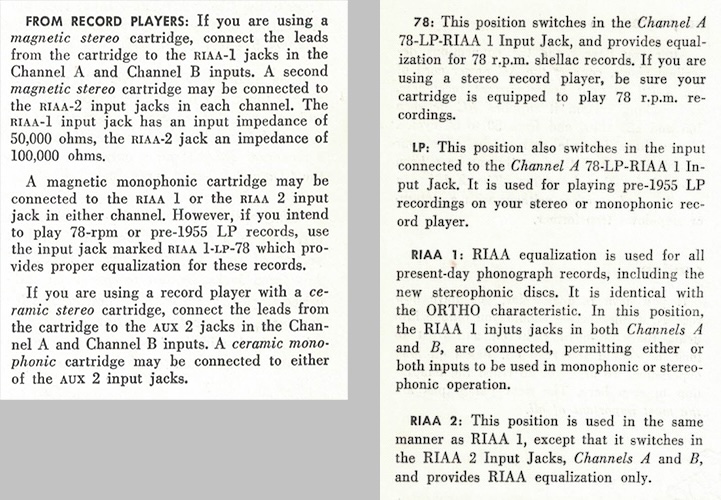
source: Installation / Operating Instructions for Fisher Stereophonic Master Control Amplifier Model X-101.
Fisher X-101 取説の入力セレクタポジション解説より
78回転盤用「78」、および、1955年以前のレコード用「LP」は、RIAA 1 入力の左チャンネルのみに作用、「RIAA」は、RIAA 1 入力および RIAA 2 入力に適用される、とある
同時に、Fisher 30-C モノーラルプリアンプも新登場となっています。こちらはフォノ入力はマグネットカートリッジ用 RIAA 1系統のみで、トーンコントロールに「LP」「78」と印字されており、簡易的・擬似的に微調整を行うようになっています。
At the same time, the Fisher 30-C monaural preamplifier is also new. This model has only one RIAA phono input for magnetic cartridges, and “LP” and “78” are printed around the tone control knobs for simple/pseudo fine-tuning.
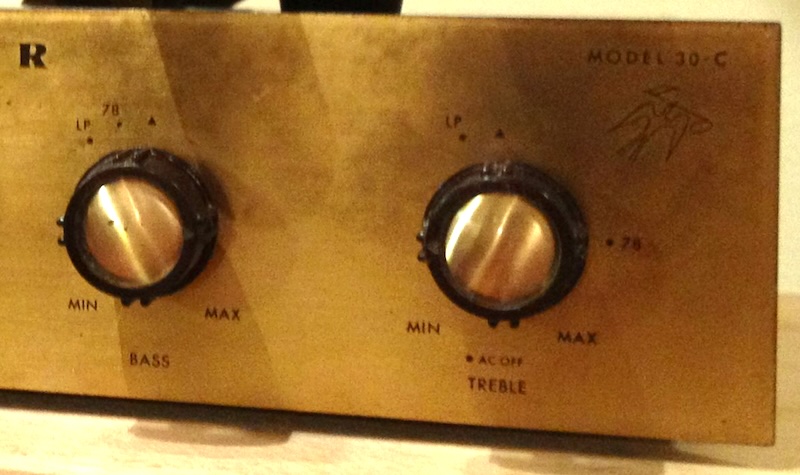
source: Pinterest.
Fisher 30-C Master Audio Control モノーラルプリアンプのトーンコントロール部
それぞれに「LP」「78」とラベリングされており、トーンコントロールで可変カーブの代用としていることが分かる
フォノ入力は「RIAA (PHONO)」1系統のみで、圧電式カートリッジは AUX から入力して簡易利用するスタイル
| Model | Kind / Phono Pos. |
|---|---|
| Fisher X-101 STEREO |
Integrated Amp, 20W×2 |
| Input 1: LP / 78 / RIAA (left channel only except RIAA) Input 2: RIAA |
|
| Fisher 400-C STEREO |
Preamp |
| Input 1: LP / 78 / RIAA (left channel only except RIAA) Input 2: RIAA |
|
| Fisher 30-C mono |
Preamp |
| RIAA; variable tone control (marked LP / 78) | |
| Fisher PR-66 STEREO |
Preamp |
| RIAA | |
| Fisher PR-6 mono |
Preamp |
| RIAA | |
| Fisher TA-500 mono |
Tuner-Amp, 30W |
| AES / RIAA / LP / NAB |
1959: Bogen
Bogen も、3種類のステレオアンプを登場させています。新製品では非RIAA EQのポジションはますます減り、かろうじて DB230 に「US78」のみが残るのみとなっています。
Bogen has also introduced three new stereo amplifiers. The non-RIAA EQ positions are increasingly fewer in the new products, with only the “US78” position barely remaining in the DB230.
| Model | Kind / Phono Pos. |
|---|---|
| Bogen DB230 STEREO |
Integrated Amp, 30W×2 |
| US78 / RIAA | |
| Bogen DB212 STEREO |
Integrated Amp, 12W×2 |
| RIAA | |
| Bogen AC210 STEREO |
Integrated Amp, 10W×2 |
| RIAA | |
| Bogen DB125 mono |
Integrated Amp, 25W |
| 78 / Old / RIAA | |
| Bogen DB114 STEREO |
Integrated Amp, 14W×1 (another amp needed) |
| 78 / RIAA | |
| Bogen DB130-A mono |
Integrated Amp, 35W |
| Eur 78 / US 78 / AES / RIAA / COL-LP / NAB / POP | |
| Bogen AC10 mono |
Integrated Amp, 10W |
| Magnetic (RIAA) / Crystal |
1959: McIntosh
続いて McIntosh ですが、モノーラル用の C-8 をステレオ化するための C-8S アドオンステレオプリアンプが登場しています。
Following is McIntosh. The new product, C-8S, is an add-on stereo preamplifier, to convert the C-8 monaural preamplifier into stereo.
| Model | Kind / Phono Pos. |
|---|---|
| McIntosh C-8 Audio Compensator mono |
Preamp |
| Turnover: combination of 280 / 400 / 580 / 750 / 950 Rolloff: combination of 5 / 10 / 15 / 20 / 25 |
|
| McIntosh C-8S “Add-On” Stereo Preamp mono STEREO |
Preamp |
| Turnover: combination of 280 / 400 / 580 / 750 / 950 Rolloff: combination of 5 / 10 / 15 / 20 / 25 |
1959: Marantz
Marantz は、というと、プリアンプは依然として Audio Consolette だけで、2台同時使用でマスターボリュームをコントロールするための STEREO CONTROL UNIT というパッシブプリのような製品が追加されているのみです。
Marantz, on the other hand, still has only the Audio Consolette preamplifier, with the addition of a passive preamp-like product called the “STEREO CONTROL UNIT” for controlling master volume when two Audio Consolette units are used simultaneously.
| Model | Kind / Phono Pos. |
|---|---|
| marantz Audio Consolette mono |
Preamp |
| Turnover: FLAT / 300 / 400 / 500 ORTHO / 500 COL / 800 Rolloff: FLAT / 5000 -3dB / 2500 / 2000 / 1500 / 1000 -2.5dB |
1959: Sherwood, Madison-Fielding
Sherwood はアドオン方式のステレオアンプ1種を新たにラインアップ、フォノEQは RIAA 固定となっています。
Sherwood has added an “add-on” stereo amplifier to its lineup. The phono EQ of the new add-on amplifier is RIAA only.
一方、前年のカタログにはなかった Madison-Fielding というブランドも登場しています。その Madison-Fielding 320 というステレオアンプでは、回路図の実装 および 本体写真 を確認する限り、「RIAA」「AES」などとラベリングされた可変抵抗によるダイアル「PREAMP」が左右チャンネルにそれぞれ独立装備されていたようです。
Additionally, a brand called Madison-Fielding, which was not in the previous year’s catalog, was also listed. The Madison-Fielding 320 stereo amplifier seems to have had independent “PREAMP” variable register dials labelled “RIAA”, “LP”, “Eur” and “AES” for the left and right channels, according to the circuit diagram implementation as well as the photo of the amplifier itself.
| Model | Kind / Phono Pos. |
|---|---|
| Sherwood S-4000 “Add-On” STEREO |
Integrated Amp, 20W×1 (another amp needed) |
| RIAA | |
| Sherwood S-1000 II mono | Integrated Amp, 36W |
| LP / Lon. / RIAA-AES / Eur | |
| Sherwood S-1060 mono |
Integrated Amp, 60W |
| LP / Lon. / RIAA-AES / Eur | |
| Madison-Fielding 320 STEREO |
Integrated Amp, 40W or 20W×2 |
| RIAA; variable “preamp” control (marked RIAA / LP / Eur / AES) |
1959 Allied Catalog: Summary and My Impression
| Stereo | 20 |
|---|---|
| Add-On Stereo | 3 |
| Mono | 21 |
| Tube | 44 |
|---|---|
| Transistor | 0 |
| RIAA only | 12 |
|---|---|
| RIAA w/ pseudo EQ (tone control) | 6 |
| Switchable EQ | 23 |
| Variable EQ (Turnover / Rolloff) | 3 |
この1959年版カタログ(1958年秋出版)から、45/45 ステレオレコード対応のアンプが登場します。初年度ということもあり、ステレオアンプとモノーラルアンプの比率はほぼ半数です。ステレオプリ+片チャンネルパワーという、ステレオ黎明期らしいアドオンインテグレーテッドアンプも興味深いです。
From this 1959 catalog (published in the fall of 1958), 45/45 stereo record-compatible amplifiers are introduced. Since this is the first year, the ratio of stereo / monaural amplifiers is almost half. It is also interesting to note that the “add-on” stereo integrated amplifier (a combination of stereo preamp + one channel power amp), which is typical of the early days of stereo.
また、RIAA のみ対応のフォノイコ回路を内蔵したアンプが、明らかに増えてきているのが分かります。そして、H.H. Scott / Pilot / Fisher / Madison-Fielding のアンプにみられるように、簡易的にトーンコントロールでEQカーブの代用とする、という実装が目立つのも特徴的です。
Also, we see a clear increase in the number of “RIAA-only phono” amplifiers. Another characteristic is the use of a simple tone control as a substitute for the precise EQ curve, as seen in the H.H. Scott / Pilot / Fisher / Madison-Fielding amplifiers.
もっとも興味深いのは、KNIGHT KN-720、Bell 3030、Fisher X-101、Fisher 400-C というステレオアンプ4機種でしょう。これらは、フォノEQカーブを3種類から選択可能なのですが、あくまで片チャンネルに対してのみ有効(もう片チャンネルは RIAA 固定)というものです。つまり、これらのメーカ/製品は、非RIAAはモノーラル時代にのみ適応されるもの、という認識で設計開発されたものである、ということになります。
Perhaps the most interesting are four stereo amplifiers: the NIGHT KN-720, Bell 3030, Fisher X-101 and Fisher 400-C. These have three selectable phono EQ curves built-in, but they are only effective for the left channel (the right channel is fixed to RIAA). In other words, these manufacturers (and their products) were designed and developed with the understanding that non-RIAA curve is only applicable to old records from the monaural era.
22.1.3 1960 Allied Radio Catalog No. 190 (Sep. 1959)
1959年秋発行の1960年カタログでは、さらにステレオ化が進んでいるでしょうか。アンプ内蔵フォノイコはどうなっているでしょうか。
Were the amplifiers listed in the 1960 Allied Catalog (published in the fall of 1959) even more stereo? ALso, what about the phono preamplifiers built into those amplifiers?
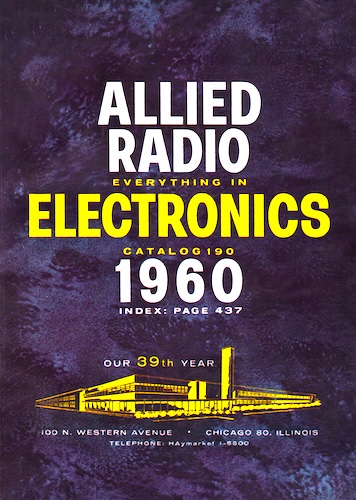
Allied Catalog 冒頭のお馴染み「おすすめコンポ組み合わせ」ページは6〜21ページにありますが、1960年カタログでは Allied ブランドの KNIGHT アンプとスピーカを組み込んだものだけになっています。昨年度までは他社製のみで組み合わされたコンポセットもあったのですが。
The familiar “Recommended Component Sets” at the beginning of the Allied Catalog are on pages 6 through 21, but in this 1960 catalog, only the combinations of KNIGHT amplifiers and speakers are listed. Until last year, there were some component sets that wre combined only with other manufacturers’ products.
ともあれ、その16ページ中、14ページがステレオシステムで、モノーラルシステムは1ページ3セットのみ、しかも DIY キット(一部自作が必要)のみとなっています。
Anyway, 14 out of those 16 pages are stereo systems. Only three sets of monaural DIY kit systems appear in a single page.
1960 Allied Catalog: Summary and My Impression
| Stereo | 34 |
|---|---|
| Add-On Stereo | 1 |
| Mono | 7 |
| Tube | 42 |
|---|---|
| Transistor | 0 |
| RIAA only | 25 |
|---|---|
| RIAA w/ pseudo EQ (tone control) | 6 |
| Switchable EQ | 10 |
| Variable EQ (Turnover / Rolloff) | 1 |
1959年秋発行の1960年度カタログともなると、大半がステレオアンプとなっているのが確認できます。少数派となったモノーラルアンプは、従来からの製品ばかりです。
With the 1960 catalog (fall 1959), we can see that the majority of the products are stereo amplifiers. The monaural amplifiers, which are now in the minority, are all precedent models.
KNIGHT ブランドのアンプは、毎年のように新製品が投入されていたようです。それらインテグレーテッドアンプのフォノ入力セレクタは、「PHONO (CER)」(圧電式カートリッジ用)と「PHONO (MAG)」(マグネットカートリッジ用)の2入力のみへ、本格的移行が進んでいるように見受けられます。
New KNIGHT brand amplifiers seemed to be introduced every year. PHONO input selectors of these amplifiers seems to be shifting in earnest, toward the combination of “PHONO (CER)” (for piezo-electric cartridges) and “PHONO (MAG)” (for magnetic cartridges).
つまり、フォノEQとしてはRIAAオンリーへの収斂を目指しており、1955年以前のモノーラル盤や78回転盤の再生対応はトーンコントロールに委ねる、という判断です。
That is, the manufacturer’s decision might be made to converge on RIAA-only phono EQs, and to leave the support of pre-1955 monaural and 78 rpm playback to tone controls.
H.H. Scott のステレオアンプは、1959年カタログにも掲載された 299 と 130 に加え、222 が初登場しています。222 のフォノEQはRIAAオンリーとなっています。
H.H. Scott introduced the new 222 stereo amplifier for the first time, in addition to the 299 and 130 (both already appeared in the 1959 catalog). The built-in phono EQ on the 222 is RIAA-only.
Bogen は、チューナーアンプ SRB20 が初登場で、あとは従来の改良版となっています。
Bogen‘s SRB20 receiver amp is the first to appear on the market, and the rest are improved version of the previous models.
Harman-Kardon も、この年の新モデルから、フォノEQは RIAA のみとなっています。
Harman-Kardon also started implementing RIAA-only built-in phono EQs from this year’s new models.
1959年度カタログで興味深い例として提示した Fisher の X-101 と 400-C の片チャンネルのみ非RIAA選択可能という機能は、この年の改良モデル X-101A と 400-CA にも引き継がれています。
Fisher released new models, X-101A and 400-CA, which are improved versions of X-101 and 400-C respectively, also carries the interesting feature of “non-RIAA selectivity only on left channel”.
FM/AMチューナ内蔵プリアンプの Fisher 100-T と 202-T では、RIAA ベースで、「LP」「RIAA」「NAB」「78」とラベルが添えられたトーンコントロールで微調整する、という簡易的な対応となっています。
The Fisher 100-T and 202-T tuner-preamps are RIAA-based, with pseudo support with tone controls labeled “LP”, “RIAA”, “NAB” and “78”.
Bell のステレオアンプのラインアップは、1959年カタログ掲載分と比較するとずいぶん増えています。
Bell‘s stereo amplifier lineup has grown considerably since the 1959 catalog.
1959年版カタログのところで書いた通り、Bell 3030 では、Eur / RIAA / LP 用に別々のRC回路が実装されているのは片チャンネルのみで、もう一方のチャンネルは3ポジションともに同じRIAA用のRC回路が共通で使われていました。これは1960年のフラッグシップ新製品 Bell 6060 でも同様に引き継がれていることを確認しました。
As noted in the 1959 catalog, the Bell 3030 had separate RC circuits for Eur / RIAA / LP on only left channel, while the right channel shared the same RIAA RC circuit for all three positions. I have confirmed that this was also carried over to the new flagsip Bell 6060 in the 1960 catalog.
Sherwood もついにアドオン式ではない通常のステレオアンプ S-5000 をライナップしました。やはり RIAA オンリーの対応です。
Sherwood has finally added a non-add-on stereo amplifier to its lineup, the S-5000, which has a built-in RIAA-only phono EQ.
Pilot のステレオアンプ3製品は、回路図を見る限り、トーンコントロールによる擬似的な非RIAA対応となっています。
The three Pilot stereo amplifiers are pseudo-non-RIAA compatible with tone controls, as shown in the schematic.
McIntosh からは、モノーラルの C-108 / C-8 に代わり、ステレオプリアンプの C-20 がデビューしています。ターンオーバー (BASS) / ロールオフ (TREBLE) 独立調整型の本格的な可変フォノEQが内蔵されています。
McIntosh debuts the new C-20 stereo preamplifier, replacing the mono preamps C-108 and C-8. A full-fledged variable phono EQ with independent turnover (BASS) / rolloff (TREBLE) adjustments it built in.
1960年当時の C-20 初期型の回路図 を見ると、BASS / TREBLE それぞれに独立のRC回路が構成されていますが、抵抗値ではなくキャパシタ(コンデンサ)容量の違いのみでそれぞれのフォノEQカーブを実装しているのが非常に興味深いところです。
It is very interesting to note that the circuit diagram of the early C-20 from 1960 shows independent RC circuits for BASS and TREBLE, but each phono EQ curve is implemented only by the difference in capacitance, not registance.
なお、1962年以降の C-20 後期型モデルの回路図 によると、抵抗値とキャパシタ容量の違いでそれぞれのフォノEQカーブを実装するように変更されているようです。
According to the circuit diagram of C-20 later model after 1962, the implementation for each EQ curve is by the difference of both resistance and capacitance.
本カタログ初登場となる General Electric (GE)、Dynakit (Dynaco)、EICO は、いずれも RIAA オンリーでした。
General Electric (GE), Dynakit (Dynaco) and EICO, all appearing in the Allied Catalog for the first time, were RIAA-only.
GE MS-2000 と MS-4010 は、背面の入力端子が PHONO(ステレオ)と MON PHONO(モノーラル)と2系統あるのが確認できます。当然、後者は1チャンネル分しかありません。
General Electric’s tow amplifiers, MS-2000 and MS-4010, both have two phono inputs on the rear panel, PHONO (stereo) and MON PHONO (monaural). Naturally, the latter is only one channel input.
22.1.4 1961 Allied Radio Catalog No. 200 (Sep. 1960)
1960年秋発行の1961年度カタログでは、インテグレーテッドアンプ / チューナアンプ / プリアンプは、多くのメーカでモノーラルアンプがラインアップに存在しなくなってきており、ますます市場のステレオ化が進んでいるのが確認できます。
The 1961 Allied Catalog (issued in the fall of 1960) confirms the increasing shift to stereo of the market for integrated amplifiers / receivers / preamplifiers, as many manufacturers no longer have monaural amplifiers in their lineup.
Bell Sound 社のオーディオ製品は、この1961年度版カタログにはなぜか掲載されていません。
Bell Sound’s audio products are not listed in this 1961 catalog somehow.

1961 Allied Catalog: Summary and My Impression
| Stereo | 41 |
|---|---|
| Mono | 4 |
| Tube | 45 |
|---|---|
| Transistor | 0 |
| RIAA only | 29 |
|---|---|
| RIAA w/ pseudo EQ (tone control) | 5 |
| Switchable EQ | 9 |
| Variable EQ (Turnover / Rolloff) | 2 |
ますますフォノEQ セレクタが撤廃され、RIAA のみとなっていく傾向が見られます。充実した可変フォノEQカーブ対応の民生用アンプの先駆けだった maranz ですら、初のステレオ版プリアンプである Model 7 Stereo Console では、RIAA / old 78 / old Col LP の 3ポジションからのみ選択可能となっています。
The trend is toward the elimination of the phono EQ selector and the use of RIAA only. Even marantz, the pioneer of consumer amplifiers with a full range of variable phono EQ curves, has only three selectable positions on its Model 7 Stereo Console, marantz’s first stereo preamp: RIAA, old 78 and old Col LP.
一方、数年前から存在する McIntosh C-20 以外にも、H.H. Scott 122(入力セレクタで 78 / Orig. AES / RIAA / Orig. Col. を選択可能) や、Harman-Kardon Citation I(ターンオーバーとロールオフをそれぞれ複数から選択可能)のように、ステレオアンプ新製品であるのに充実したフォノEQ選択ポジションを備えた製品も一部みられます。
On the other hand, in addition to McIntosh C-20 (which as been around for several years), there are some new stereo amplifiers with extensive phono EQ selection positions, such as the H.H. Scott 122 (78 / Orig. AES / RIAA / Orig. Col. selectable with input selector) and the Harman-Kardon Citation I (multiple turnover and rolloff selections respectively).
これは、オーディオマニアの間でのステレオブームがひと段落して、古いモノーラル盤の良さが見直され出したことを反映しているのかもしれません。
This may reflect the probable fact that the stereo boom among audiophiles had slowed down a bit, and the quality of old monaural recording was being reevaluated.
もちろん、いずれの取扱説明書にも、「ステレオレコードは RIAA ポジションで聴くこと」と書かれてはいます。
Of course, both instruction manuals state that “stereo records should be listened to in the RIAA position”.
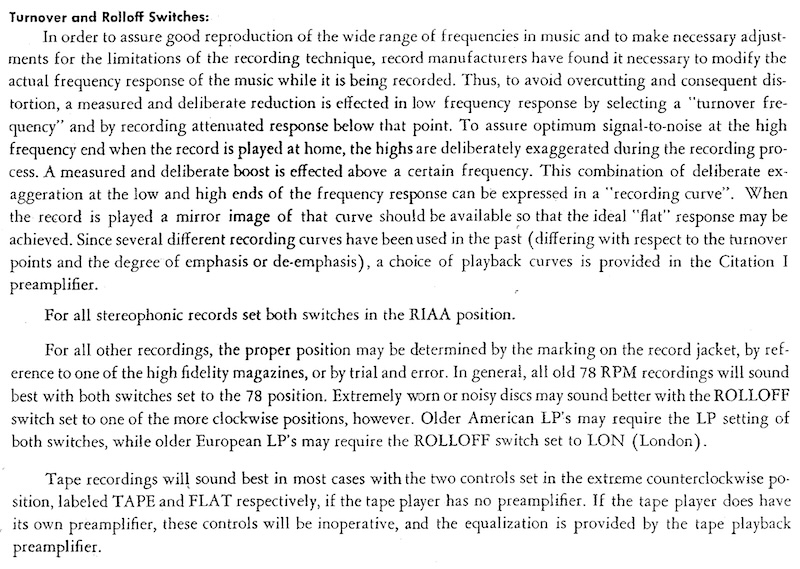
source: ManualsLib.
Harman-Kardon Citation I 取説中、ターンオーバー/ロールオフを説明する箇所
「ステレオレコードではRIAAにあわせること」「それ以外は、ジャケットに書かれた情報や High Fidelity 誌の情報を参考にし、あるいは試行錯誤を繰り返して設定すること」とある
またこれらのアンプは、KNIGHT KN-720、Bell 3030、Fisher X-101 / 400-C のような片チャンネルのみ非RIAA対応、という過渡期の仕様ではなくなり、左右チャンネル共に同一回路で非RIAA対応としています。
In addition, these amplifiers no longer have the transitional specifications as seen in KNIGHT KN-720, Bell 3030, Fisher X-101 and 400-C, in which only one channel is non-RIAA compatible. Instead, both channels are non-RIAA compatible with the equivalent circuits.
こちらは、片チャンネルだけ可変カーブ対応では、すでにステレオ化されてしまったシステムで聴くのが不自然だから、センター定位で旧音源を聴く需要に応えたためなのかもしれません。「MONO/STEREO」スイッチはありましたが、この場合の MONO ポジションは、左右チャンネルのブレンドであることが多かったはずですので。
This may be due to meeting the demand for listening to old records in phantom center position: although many amplifiers had the “MONO/STEREO” switch. the “MONO” position would blend both channels.
22.1.5 1962 Allied Radio Catalog No. 210 (Sep. 1961)
1962年度版カタログ(1961年秋発行)では、新製品としてソリッドステートのインテグレーテッドアンプが各社から登場しているのが特徴といえそうです。
The 1962 Catalog (issued in the fall of 1961) seems to be characterized by the appearance of solid-state integrated amplifiers from various companies as new products.
1959年度版カタログ掲載の Fisher X-101、および1960年度版カタログ掲載の Fisher X-101A は、左チャンネルのみ RIAA / LP / 78 対応という仕様でしたが、その後継である X-101B は RIAA オンリーとなっています。
The Fisher X-101 in the 1959 catalog, as well as Fisher X-101A in the 1960 catalog were RIAA / LP / 78 compatible on the left channel only, but their successor, X-101B, is now RIAA-only.
また、昨年度ではカタログ落していた旧製品 H.H. Scott 99-D モノーラルアンプが再度復活していたり、1950年代後半登場の有名な Dynaco Dynakit PAM-1 モノーラルプリアンプが改めて掲載されているのも、1961年秋というタイミングを考えると興味深いです。
Given its timing, fall 1961, it is also interesting that the old H.H. Scott 99-D monaural amplifier, which was dropped from the catalog in the previous year, is back again. And the famous Dynaco Dynakit PAM-1 monaural preamplifier, which appeared in the late 1950s catalogs, is listed again.
Bell Sound 社のオーディオ製品は、1961年度版カタログに続き、今回も掲載されていません。
Bell Sound’s audio products are not listed in the 1961 catalog, and they are not listed here either.
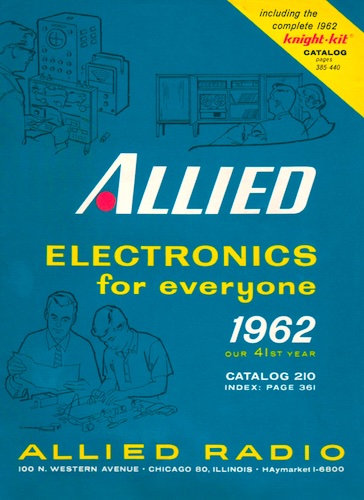
1962 Allied Catalog: Summary and My Impression
| Stereo | 51 |
|---|---|
| Mono | 4 |
| Tube | 50 |
|---|---|
| Transistor | 5 |
| RIAA only | 44 |
|---|---|
| RIAA w/ pseudo EQ (tone control) | 1 |
| Switchable EQ | 8 |
| Variable EQ (Turnover / Rolloff) | 2 |
トーンコントロールノブに簡易的にカーブ名が書かれているアンプは1機種のみに激減し、全機種の81%が RIAA オンリーとなっていることが確認できます。
The number of amplifiers with simple implementation of “EQ curve names on the tone control knobs” has been drastically reduced to only one model, and 81% of all models in the 1962 catalog can be confirmed to be RIAA-only.
ターンオーバー/ロールオフ独立調整方式可変カーブフォノイコは、McIntosh C-20 プリアンプのみとなり、その他は RIAA / Columbia LP / 78 の選択が行える程度です。
The only amplifier with variable curve phono preamp (w/ independent turnover / rolloff adjustment) is McIntosh C-20 preamplifier, and others only offer the switch among RIAA / Columbia LP / 78.
22.1.6 1963 Allied Radio Catalog No. 220 (Sep. 1962)
1963年度版カタログ(1962年秋発行)でも、新登場のソリッドステートアンプが並んでいます。モノーラルアンプは(パワーアンプを除き)旧製品以外はほとんどなくなっています。
The 1963 Catalog (issued in the fall of 1962) also features a bunch of newly-introduced solid-state amplifiers. Most of the monaural amplifiers are gone (some power amplifiers were offered in mono though), except for the older models.
1961年度版、1962年度版と掲載されていなかった Bell Sound のアンプが復活しています。
Bell Sound amplifiers, that were not listed in the 1961 and 1962 catalog, are back in the 1963 edition.
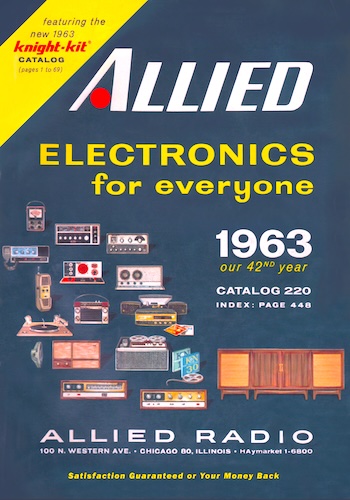
1963 Allied Catalog: Summary and My Impression
| Stereo | 64 |
|---|---|
| Mono | 3 |
| Tube | 59 |
|---|---|
| Transistor | 8 |
| RIAA only | 54 |
|---|---|
| RIAA w/ pseudo EQ (tone control) | 1 |
| Switchable EQ | 9 |
| Variable EQ (Turnover / Rolloff) | 3 |
トーンコントロールノブに簡易的にカーブ名が書かれているアンプは引き続き Pilot 240 の1機種のみで、全機種の80%が RIAA オンリーです。
The Pilot 240 continues to be the only amplifier with simple implementation of “EQ curve names on the tone control knobs”, and 80% of all models are RIAA-only.
この1963年カタログでは、のちの McIntosh C-22 の先駆けとなる McIntosh C-11(RIAA/LP切替スイッチ式)が新登場しているほか、トランジスタ式プリアンプの新製品 Harman-Kardon Citation “A” でも、ターンオーバー/ロールオフ独立調整方式のフォノイコライザが搭載されるなど、非RIAAへの対応への回帰がわずかながら見受けられます。
In this 1963 catalog, the McIntosh C-11, the forerunner of the later McIntosh C-22 and RIAA/LP switchable, was newly introduced, and the new transistor-based preamplifier, the Harman-Kardon Citation “A” also features a phono equalizer with independent turnover / rolloff adjustments. Thus, there might be a slight return to non-RIAA compatibility.

source: McIntosh Stereo Preamplifier C11 Owner’s Manual
C-11 取説で RIAA / LP 補正スイッチについて解説する箇所
しかしこれらは、ステレオ盤の非RIAAによる再生を目論んだものではないでしょう。むしろ、モノーラル盤の再評価が進んだことで、古いレコードにも最新のレコードにも対応できる多機能かつ万能なアンプが求められたからと考えられます。
However, these would not have been intended for non-RIAA playback of stereo records. Rather, it is likely that the reevaluation of monaural recordings was driven by the need for a versatile amplifier that could handle both older and more recent disc recordings.
実際、可変フォノEQを備えたステレオアンプの取説では、いずれのメーカのものであっても「ステレオレコードはRIAAポジションで聴くこと」と書かれています。
In fact, any instruction manuals for these stereo amplifiers with variable phono EQ state that “stereo records should be listened to in the RIAA position”, regardless of the manufacturer.
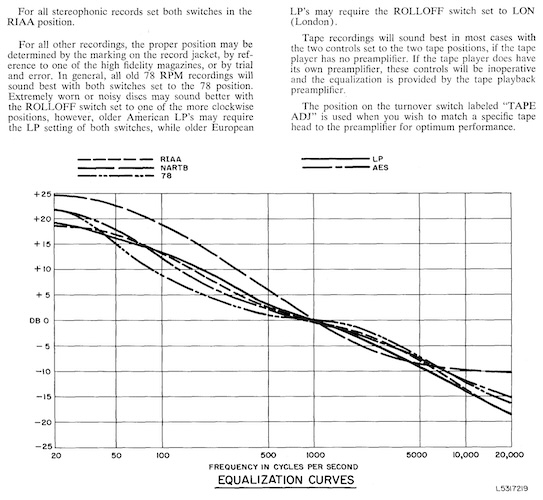
source: ManualsLib
Harman-Kardon Citation “A” 取説より
“For all stereophonic records set both switches in the RIAA position” と明記されている
また、ステレオレコード黎明期のアンプの中には、「3rd Channel Output」という出力端子を備えたものが少なくありません。特に最初期のポピュラー系ステレオ録音では、設置環境によってはステレオスピーカの真ん中の音が抜けるように聞こえるため、その違和感を解消するために、モノーラルアンプとセンタースピーカを接続し、左右チャンネルのブレンド信号を送るためのものでした。
In addition, many amplifiers from the early days of stereo records were equipped with a “3rd Channel Output” terminal. This was used to connect an additional monaural amplifier to drive the center speaker and send a blended signal from both channels, in order to eliminate the discomfort caused by the “hole-in-the-middle” effect, especially in the earliest popular stereo recording.
その他、2チャンネルスピーカのまま、左右入力信号のブレンド具合を調整可能とし、中抜けへの対策とした「BLEND」ノブを備えた製品(例: Harman-Kardon Citation I / IV / “A”)もありました。
Similarly, other products (such as Harman-Kardon Citation I / IV / “A”) were equipped with a “BLEND” knob that allows adjustment of the degree of blending of the left/right input signals while the two-channel loudspeaker remains in use, as a countermeasure against “hole-in-the-middle” effect.
このように、過去のモノーラル音源の遺産を活かしつつ、登場まもないステレオ音源も楽しめるよう、現代の2チャンネルステレオアンプの標準的なプラクティスに至るまでには、製造メーカ(そしておそらくは購入者や評論家からのフィードバック)の試行錯誤があったことが伺えます。
Thus, it is clear that there was a process of trial and error by manufacturers (and perhaps feedback from customers and critics) to arrive at standard practices for modern 2-channel stereo amplifiers that would allow people to enjoy stereo sounds sources soon after their appearance, while also taking advantage of the heritage of monaural sound sources from the past.
22.1.7 1964 Allied Radio Catalog No. 230 (Sep. 1963)
1964年度版カタログ(1963年秋発行)での注目点は、McIntosh C-22 プリアンプの登場です。
A highlight of the 1964 Catalog (issued in the fall of 1963) was, for me, the appearance of the McIntosh C-22 preamplifier.
このプリアンプは、マグネットフォノ入力2系統を備えており、フロントパネルに「RIAA / LP」切り替えスイッチを持っているのですが、問題はこの C-22 の取扱説明書の文言にあります。こちらについては、本サブセクション末尾で改めて触れます。
This preamplifier has two magnet phono inputs, and has a “RIAA / LP” switch on the front panel, but the problem lies in the wording of the C-22’s operating manual. We will discuss it again at the end of this subsection.
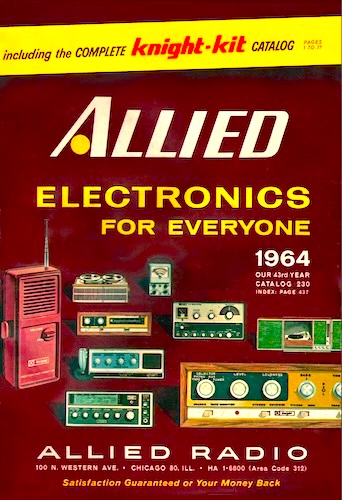
1964 Allied Catalog: Summary and My Impression
| Stereo | 62 |
|---|---|
| Mono | 4 |
| Tube | 58 |
|---|---|
| Transistor | 8 |
| RIAA only | 58 |
|---|---|
| RIAA w/ pseudo EQ (tone control) | 0 |
| Switchable EQ | 6 |
| Variable EQ (Turnover / Rolloff) | 2 |
本年度カタログから Pilot 製品がカタログに掲載されなくなったことで、トーンコントロールノブで簡易的にカーブ対応するアンプがついに存在しなくなりました。
With the Pilot products no longer listed in this year’s catalog, there are finaly no more amplifiers with a tone control knobs for pseudo-curve support.
結果として、1964年度版 Allied Radio カタログに掲載された 非RIAA対応のステレオアンプ は、以下の6機種のみとなりました(残る2機種はモノーラルアンプ)。うち、昔ながらのターンオーバー/ロールオフ調整式は Harman-Kardon の 2機種、あとの4機種は2〜3ポジションからの切替式となっています。
As a result, only the folowing six non-RIAA stereo amplifiers were listed in the 1964 Allied Radio Catalog (the remaining two were monaural). Of these, two Harman-Kardon models only had the traditional turnover/rolloff adjustment, and the other four had two or three EQ positions to switch between.
| Model | Description |
|---|---|
| Fisher X-1000 Integrated Amp | RIAA / COL |
| Harman-Kardon Citation “A” Preamp | Turnover: 500 / RIAA / LP / AES / 78 Rolloff: 78 / LON / AES / RIAA / LP |
| Harman-Kardon Citation I Preamp | Turnover: 78 / AES / LP / RIAA / 800 Rolloff: FLAT / 78 / LON / AES / RIAA / LP |
| Harman-Kardon Citation IV Preamp | RIAA / COL |
| McIntosh C-22 Preamp | RIAA / COL |
| Marantz Model 7 Stereo Console Preamp | RIAA / old 78 / old COL LP |
McIntosh C-20 から C-22 に世代が変わったタイミングで、ターンオーバー/ロールオフ調整式をやめ、C-11 同様の RIAA/COL スイッチのみとしていることが特徴的ですが、一方で Harman-Kardon Citation シリーズでは、比較的新しいソリッドステートプリアンプでも、まだターンオーバー/ロールオフ調整式を採用しているのが興味深い点です。
It is interesting to note that at the time of the generation change from the McIntosh C-20 to the C-22, the turnover/rolloff adjustment system was dropped, and only the RIAA/COL switch, similar to the C-11, was introduced. On the other hand, also interesting is that the Harman-Kardon Citation series still uses the turnover/rolloff adjustment system, even for relatively new solid-state preamplifiers.
とはいえ、1機種を除き、これらのアンプの取説には「ステレオレコードはポジションを RIAA にすること」と書かれています。
Nevertheless, with the exception of one particular model, the operating manuals for these amplifiers state that the position should be set to RIAA for stereo records.
唯一の例外が、McIntosh C-22 管球式プリアンプ(および翌年登場の C-24 ソリッドステートプリアンプ / MA230 インテグレーテッドアンプ)です。取説には次のような文言が掲載されています。
The only exception is the McIntosh C-22 tube preamplifier (and the C-24 solid-state preamplifiers as well as MA230 integrated amplifier, that appeared in the following year). The owner’s manual includes the following statement.
Use the COMP switch to correct for phono equalization introduced by the recording process. All current LP and Stereo recordings use RIAA equalization. Some stereo and early mono recordings use LP equalization.
レコードマスタリング時のフォノEQを補正するために、COMP (補正) スイッチを使用すること。現在流通している(注: C-22 が初登場した1963年時点)全ての(モノーラル)LP、およびステレオレコードは、RIAA カーブが使用されている。一部のステレオ盤、および初期の(モノーラル)レコードでは LP カーブが使用されている。
McIntosh C-22 Stereo Preamplifier Owner's Manual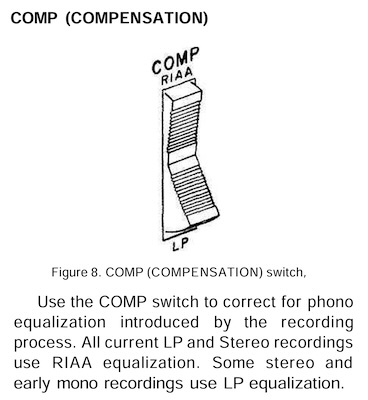
source: McIntosh C-22 Owner’s Manual.
“Some stereo and early mono recordings use LP equalization” という問題の記述がある箇所
1959年に登場した、ターンオーバー/ロールオフ調整式の McIntosh C-20 の取説には、レーベル名と推奨カーブの一覧表が掲載されていますが、そこには「モノーラル盤」と明記されていました。
The owner’s manual for the McIntosh C-20 (1959) with adjustable turnover/rolloff, listed the record label names and their recommended curves, which were clearly noted as “for monaural records”.
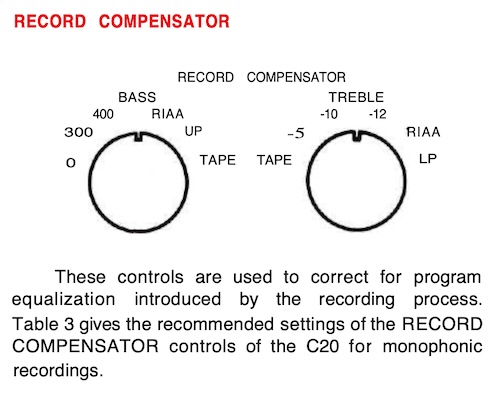
source: McIntosh Stereo Preamplifier C20 Owner’s Manual
C-20 取説でターンオーバー/ロールオフ補正ノブについて解説する箇所
正しく “for monophonic recordings” と書かれている
1961年に登場した、RIAA/COL 切替スイッチ式の McIntosh C-11 の取説には「このスイッチはレコードマスタリング時のフォノEQを補正するためのものである (This control corrects for phono equalization introduced by the recording process)」とのみ書かれており、なんの言及もありません。
The owner’s manual for the McIntosh C-11 (1961) with the RIAA/COL switch, states only that “This control corrects for phono equalization introduced by the recording process”.

source: McIntosh Stereo Preamplifier C11 Owner’s Manual
C-11 取説で RIAA / LP 補正スイッチについて解説する箇所
ところが、1963年登場の McIntosh C-22、そして 1964年登場の C-24 / MA230 の取説では、なぜか「一部のステレオ盤および初期の(モノーラル)レコードでは LP カーブが使用されている」と書かれているのです。
However, for some reason, the owner’s manuals for the McIntosh C-22 (1963), McIntosh C-24 (1964) and McIntosh MA230 (1964), state that “Some stereo and early mono recordings use LP equalization”.
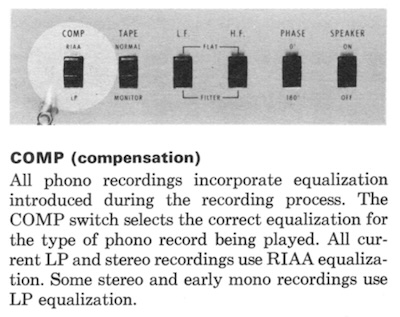
source: McIntosh C-24 Owner’s Manual.
C-22 取説にもあった “Some stereo and early mono recordings use LP equalization” という問題の記述が踏襲された箇所
ちなみに、後継機種である McIntosh C-26(1968年登場)以降は、RIAA カーブのみとなっています。
Interestingly, its successor, the McIntosh C-26 (1968) and later models are RIAA only.
なぜ、C-22 / C-24 / MA230 の取説に、わざわざこのような文言が追加されたのか、その真意や背景を確認すべく、McIntosh Labs に問い合わせをしてみたのですが、「当時のアンプを設計開発したエンジニアは全員鬼籍に入っているため、インタビューなどによって本件を確認することができない」という回答でした。
I tried to contact McIntosh Labs to find out why such a statement was added to the owner’s manuals of the C-22, C-24 and MA230. But their reply was: “the folks that were engineering these preamps, C20, 22 and 24 have all passed away so we are not able to interview them about your questions”.
よって、残念ながら、なぜ「一部のステレオ盤」という文言を C-22 / C-24 / MA230 の取説のタイミングで追加したのか、は永遠の謎となってしまいました。
Therefore, unfortunately, why the phrase “some stereo (records)” was added to the C-22 / C-24 / MA230’s manuals is an eternal mystery.
本稿 Pt.21 までのさまざまな調査や学びを通じて、非RIAA EQ でカットされたステレオレコードは存在しない、と考えるのが自然ですが、この McIntosh C-22 / C-24 / MA230 の文言を最大限善意に解釈するならば、「Columbia LP カーブにした方が好ましく聴けるステレオ盤もある」という意図だったのではないでしょうか。
Through the various research and studies up to Pt. 21 of my article, it is natural to assume that there are no stereo records cut with non-RIAA EQ. Therefore, if we interpret the wording of the McIntosh C-22 / C-24/ MA230 in the most benign way possible, I believe that the intention was that “some stereo records can be played back subjectively better with Columbia LP curve”.
もし、上記の解釈が真であるとするならば、多くの1960年代のレコードでは、録音フォノEQとは独立して、ヴァリアブルEQ/リヴァーブ/コンプレッサ/リミッタ/ディエッサ等が(主にポピュラー音楽のレコードで)ナイーブかつラフに使われていた、ということでもあるのでしょう。
If the above interpretation was true, it would also mean that in many record cuttings in the 1960s, variable EQs / reverbs / compressors / limiters / de-essers / etc. were naively and roughly used (mainly in popular music), independent of the recording phono EQ, I guess.
22.2 “Audio” Magazine’s Annual Product Reviews
以上、Allied Radio カタログに掲載された各種アンプを、1958年度版〜1964年度版までみてきました。
The above is a lengthy list of the various amplifiers in the Allied Radio Catalog from the 1958 to 1964 editions.
しかし、Allied Radio カタログに掲載されたアンプが、当時米国で販売されていた全てのアンプではありませんし、対象購買層も「一般リスナー」と「筋金入りのオーディオマニア」の中間くらいを狙っていたと推測されます。
However, the amplifiers listed in the Allied Radio Catalog were not all the amplifiers sold in the U.S. at the time. And it is assumed that the turget buyer was somewhere between “general listeners” and “serious audiophiles”.
そこで、「筋金入りオーディオマニア」向け雑誌の特集に掲載されたアンプがどのようなものであったか、ちょっと眺めてみましょう。
So, let’s take a look at what amplifiers featured in a special issue of a magazine for “serious audiophiles” looked like.
幸い、Audio Engineering 誌あらため Audio 誌 では、1959年以降の毎年8月号で「Buyer’s Guide」「Annual Product Preview」といった名前で最新オーディオコンポーネント特集が組まれており、ここにリストアップされた機種をヒントに、同様に回路図や取説などを追っていくことができます。
Fortunately, Audio magazine (was: Audio Engineering magazine) had annually published special issues on the latest audio components in every August since 1959, under the names of “Buyer’s Guide” and “Annual Product Preview”. We can follow the schematics, instruction manuals, etc., using the models listed here as clues.
22.2.1 “Annual Product Preview” on Audio Magazine, Aug. 1964
ここでは、Allied Radio カタログ1965年度版(1964年秋発行)に相当する、Audio 誌 1964年8月号の「Annual Product Preview Section」をみることにします。
Here we will look at the “Annual Product Preview Section” of the August 1984 issue of Audio magazine, which corresponds to the 1965 edition of the Allied Radio catalog (published in the fall of 1964).
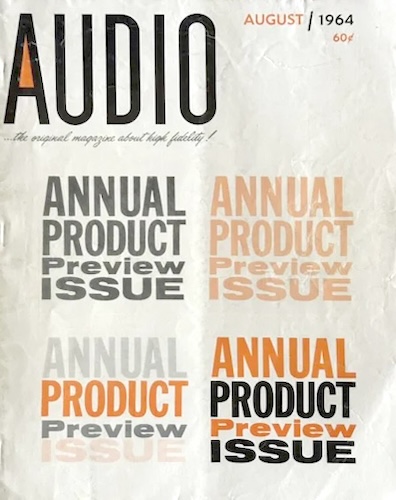
Allied Radio カタログとは異なり、英国メーカ、日本メーカの製品も列挙されています。また、Allied Radio カタログには登場しなかった Altec、HeathKit、JBL、Lafayette などのメーカも登場しており、当時の(プロフェッショナル市場向けではない)民生用高級コンポーネントが一望できます。
Unlike the Allied Radio catalog, products from British and Japanese manufacturers are also listed. ALso, manufacturers such as Alec, HeathKit, JBL and Lafayette, which did not appear in the Allied catalog, are also listed, providing an overview of high-end consumer (not professional market) components of the time.
さて、Allied Radio カタログに掲載されたアンプ群と比べて、なんらかの傾向の違いはあるでしょうか。
So, is there any difference in the trend, compared to the amplifiers in the Allied Radio Catalog?
以下、レシーバアンプ(AM/FMチューナ付インテグレーテッドアンプ)は割愛します。ステレオ43機種、モノーラル1機種が掲載されていますが、44機種のレシーバアンプは全てフォノEQがRIAAオンリーであることを確認しました。
Receiver amplifiers (integrated amplifiers with AM/FM tuners) are omitted blow. I have confirmed that all 44 receiver amplifiers (fourty-three stereo, and one monaural) have RIAA-only built-in phono EQs.
Audio Magazine Aug. 1964: Summary and My Impression
| Stereo | 76 (116 if incl. Tuner-Amps) |
|---|---|
| Mono | 1 (2 if incl. Tuner-Amps) |
| Tube | 50 (83 if incl. Tuner-Amps) |
|---|---|
| Transistor | 27 (38 if incl. Tuner-Amps) |
| RIAA only | 70 (113 if incl. Tuner-Amps) |
|---|---|
| RIAA w/ pseudo EQ (tone control) | 0 |
| Switchable EQ | 6 (7 if incl. Tuner-Amps) |
| Variable EQ (Turnover / Rolloff) | 1 |
Audio 誌1964年8月号のプロダクトプレビュー特集では、パワーアンプを除いたモノーラルアンプは、ついに DynaKit PAM-1(と Bogen RP100-BM レシーバアンプ)のみとなりました。
Audio magazine’s Aug. 1964 issue, “Product Preview” showed that the DynaKit PAM-1 (and Bogen RP100-BM receiver-amplifier) were the only monaural amplifiers, minus the power amplifiers.
また、掲載された 非RIAA対応のステレオアンプ は、以下の6機種のみとなりました(残る2機種はモノーラルアンプ)。
In addition, only the following fix models of non-RIAA compliant stereo amplifiers were listed (the remaining two are monaural).
| Model | Description |
|---|---|
| Harman-Kardon Citation “A” Preamp | Turnover: 500 / RIAA / LP / AES / 78 Rolloff: 78 / LON / AES / RIAA / LP |
| Marantz Model 7 Stereo Console Preamp | RIAA / old 78 / old COL LP |
| McIntosh C-22 Preamp | RIAA / COL |
| McIntosh C-24 Preamp | RIAA / COL |
| McIntosh MA-230 Integrated Amp | RIAA / COL |
| Quad 22 | Switchable: configurable with three switches |
うち、昔ながらのターンオーバー/ロールオフ調整式で気を吐くのは Harman-Kardon Citation “A”(1962年)の 1機種のみで、 Marantz Model 7 (1961年)、McIntosh C-22 (1963年)、C-24(1964年)、MA-230(1964年)の4機種は2〜3ポジションからの切替式となっています。
Among these, only one model, the Harman-Kardon Citation “A” (1962), boasts the traditional turnover/rolloff adjustment system, while four models, the Marantz Model 7 (1961), McIntosh C-22 (1963), C-24 (1964) and MA-230 (1964) are switchable from two to three EQ positions.
残る Quad 22(1960年)は、3つのスイッチの組み合わせで複数カーブ対応ですが、真ん中の「DISC」ボタン押下時にカーブ対応なので、フォノEQは実質4ポジションの切替式です。RIAA 以外のポジションはモノーラル時のみ有効で、ステレオ試聴時には左チャンネルのみEQカーブが変更される仕組みになっています。
The last one, Quad 22 (1960) supports multiple curves using a combination of three switches, but the phono EQ is actually a four-position switchable system, since it supports EQ curve changes only when the middle “DISC” button is pressed. The EQ curve changes only for the left channel during stereo listening.
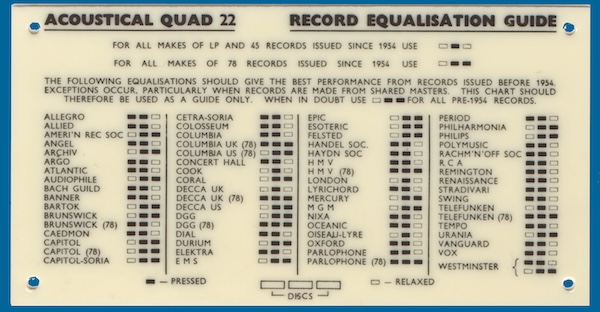
source: www.keith-snook.info.
McIntosh C-8 / C-108 を彷彿とさせる、Quad 22 プリアンプのフォノEQ設定表
1954年以前のレコードにのみ適合、と記載がある

source: www.keith-snook.info.
マイクログルーヴ盤用のポジションは2つのみ
時定数は前者が RIAA と同一、後者は RIAA の高域デエンファシスのみ NAB/Columbia LP と同一としたもの
後者は1942/1949 NAB や Columbia LP への暫定対応ということになる
Of two positions for micgoroove records, the former “3180μs, 318μs & 75μs” is the same as RIAA, while the latter is basically RIAA but the HF de-emphasis is the same as 1942/1949 NAB and Columbia LP
the latter seems to be a temporary measure for 1942/1949 NAB and Columbia LP
結果として、カジュアルなオーディオ愛好家向けの Allied Radio Catalog でも、シリアスなオーディオマニア向けの Audio 誌特集記事でも、ほぼ同様の傾向といえそうです。
As a result, it would seem that the trend is about the same as shown in the Allied Radio Catalog for casual audiophile as it is in the Audio magazine’s feature articles for the serious audiophile.
オーディオマニア向けの本格的民生用製品の世界でも、モノーラルからステレオへのシフトが進むにつれ、着実に RIAA への収束に向かっていたことが改めて確認できます。これは、「1955年以降のプロフェッショナル向けディスク録音再生用機器が、一瞬にして RIAA オンリーの世界となった」のと比べてしまうと、かなりゆっくりとした動きに見えてしまうかもしれませんが。
It can be confirmed once again that even in the world of authentic consumer produts for serious audiophiles, as the shift from monaural to stereo progressed, there was a steady convergence toward RIAA-only. One may think that it seems a rather slow movement, though, if compared to the “professional disc recording / reproducing equipment that became RIAA-only instantly after 1955”.
ともあれ、当時の名だたるオーディオメーカは、RIAA オンリーの世界へ徐々に移行し、同時に1959年頃からステレオ化を、1963年頃からトランジスタ化を、それぞれ急速に進めようとしていたことがわかります。
At any rate, it can be seen that the major audio manufacturers of the time were gradually shifting to the RIAA-only world and, at the same time, were rapidly moving to stereo from around 1959, and to transistors from around 1963, respectively.
21世紀である今の視点からは、幾多の有名なヴィンテージ機器(特に放送局などプロフェッショナル向け)に目移りし、お金さえ積めば良コンディションの個体を入手できたりするわけですが。
From the perspective of the 21st century, there are many well-known vintage equipment (especially for professionals such as broadcasting studios), and if you have enough money, you can get some good-condition units.
しかし、当時のオーディオマニアが、あえて1955年以前のヴィンテージ機器、あるいはプロフェッショナル向け機器を、猫も杓子もこぞって使っていたか。。。というと、そんなことはまず考えにくいでしょう。
However, would audiophiles of the time have dared to obtain and use pre-1955 vintage or professional equipment? It is unlikely that they did.
むしろ、正にハイファイブーム黄金期真っ只中、各メーカが競うように新技術、新製品を投入し、当時のオーディオマニアの多くがそういった技術的革新を享受し堪能していたと思われます。
In fact, it was right in the middle of the golden age of the Hi-Fi boom, when manufacturers completed to introduce brand new technologies and products, and many audiophiles of the time seemed to be enjoying and savoring such technological innovation.
もしも、これら可変EQカーブ対応の旧機種を所有する好事家向けにレコードを作っていたのだとするならば、1960年代当時1億7千万人程度だった米国民中、たかだか数千人のみに向けたスペックで、当時の大衆消費工業製品であるレコードを大量に製造していたことになります(が、そのようなことは企業の行動原理として常識的に考えられません)。
If the record manufacturers (labels) were making records especially for the enthusiasts who owned such older vintage models with variable phono EQ curves, it would mean that they were manufacturing records in large quantities, a mass consumption industrial product at the time, with specifications for only a few thousand — of the approximately 170 million people in the U.S. in the 1960s — could enjoy privileges. However, such a thing cannot be considered as a common sense principle of corporate behaviour.
22.3 The summary of what I got this time / 自分なりのまとめ
(当初、この後も続いていたのですが、余りにも長すぎるので、後半を Pt. 23 として独立させました)
(Initially this article continued after this, but as it was too lengthy, the second half has been separated as Pt. 23)
さてさて、今回の内容をざっくりまとめると、こんな感じでしょうか。
…so, the rough summary of my understanding in this Pt.22 article would be something like this:
1958年春のステレオLP登場より以前は、民生用アンプのほとんどがモノーラルで、78回転盤やRIAA規格策定前の古いレコードへの対応のために複数フォノEQポジションを備えていた。
Prior to the introduction of stereo records in the spring of 1958, most consumer amplifiers were monaural, with multiple phono EQ positions to accomodate 78 rpm records as well as old LP records before the RIAA Standards was established.
その実装方法も、トーンコントロールで簡易的に代用するもの、ターンオーバー/ロールオフの独立設定式のもの、入力セレクタに複数カーブのポジションが配置されているもの、など、各社さまざまだった。また、同一名のEQポジションであっても、機種ごとにその特性が同一である保証は全くなかったことが、回路図の比較により確認された。
The implementation methods varied from company to company, with some using tone controls as a simple substitute, others using independent turnover/rolloff settings, and others placing multiple curve positions on the input selector knob. Also, there was no guarantee that the characteristics of the EQ positions would be identical from model to model, even if they had the same EQ position name — this can be easily confirmed by inspecting the schematics of the amplifiers.
モノーラル時代には、Marantz Audio Consolette (1951)、McIntosh C-108 (1954) / C-8 (1955)、Bogen PR100A (1955)、Fisher 80-C (1956)、H.H. Scott 121-C (1956) など、ターンオーバー/ロールオフを細かく設定可能な、現代の可変カーブ対応フォノイコの源流である実装が少なくなかった。
In the monaural era, there were a number of turnover/rolloff implementations that were the source of modern variable-curve-enabled phono preamps, including Marantz Audio Consolette (1954), McIntosh C-108 (1954) / C-8 (1955), Bogen PR100A (1955), Fisher 80-C (1956), H.H. Scott 121-C (1956).
しかしステレオ時代に入ると、McIntosh C-20 (1959)、Harman-Kardon Citation I (1960) / Citation “A” (1962) という貴重な例外を除き、非RIAAカーブ対応であってもせいぜい RIAA / Columbia LP / 78 の切替スイッチを備える程度へと収斂していった。また、1960年代中頃には RIAA ポジションオンリーのアンプの比率が8〜9割程度になっていた。
However in the stereo era, with the very rare exception of the McIntosh C-20 (1959), Harman-Kardon Citation I (1960) and Citation “A” (1962) preamps, most non-RIAA-compatible amplifiers converged on the RIAA / Columbia LP / 78 rpm switch. Also, by the mid-1960s, the percentage of RIAA-only amplifiers was about 80% to 90%.
1958年〜1960年頃、すなわちステレオレコード登場直後においては、複数のフォノEQポジションに対応しているステレオアンプであっても、非RIAAカーブの場合は左チャンネルのみに作用するよう実装されていたアンプが複数メーカで確認された。また、当時の取説を読むと、どのメーカ、どの製品でも「現代のLPおよびステレオ盤はRIAAポジションで聴くこと」と書かれていた。
Around 1958 to 1960 (just after the introduction of stereophonic records), several manufacturers were found to have stereo amplifiers that supported multiple phono EQ positions but were implemented so that non-RIAA curves would act only on the left channel. In addition, the instruction manuals of the time always stated that “modern LPs and stereo recordings should be listened to in the RIAA position” for all manufacturers and products.
唯一の例外が McIntosh C-22 (1963) / C-24 (1964) / MA230 (1964) で、これらに装備された RIAA / COL 切替スイッチについて、取説では「一部のステレオ盤および古いモノーラル盤では LP(COL) カーブが使用されている」と書かれていた。これについて McIntosh に問い合わせをしたが、当時の設計・開発者が全員他界しており、文面の意図を確認することができなかった。
The only exception for this was the McIntosh C-22 (1963) / C-24 (1964) / MA230 (1964), which were equipped with a RIAA/COL switch that stated in the owner’s manual that “Some stereo and early mono recordings use LP equalization”. I contacted McIntosh about this, but all the designers/developers at that time have passed away, so I could not confirm their intent of the statement.
» 続き / Sequel: “Things I learned on Phono EQ curves, Pt.23” »


